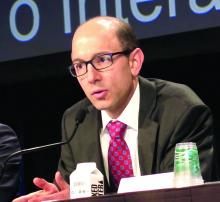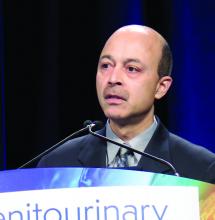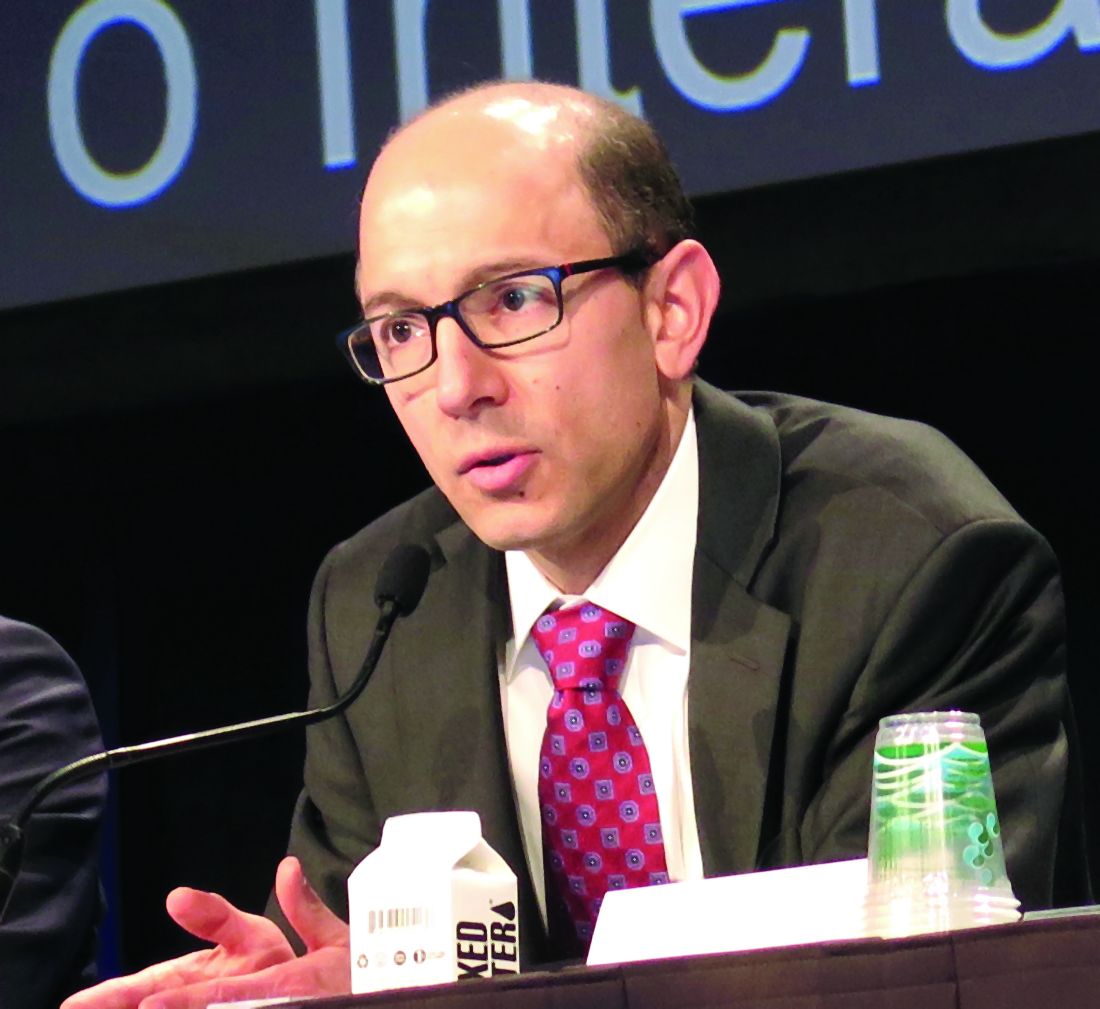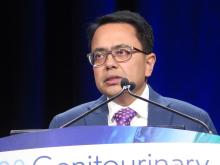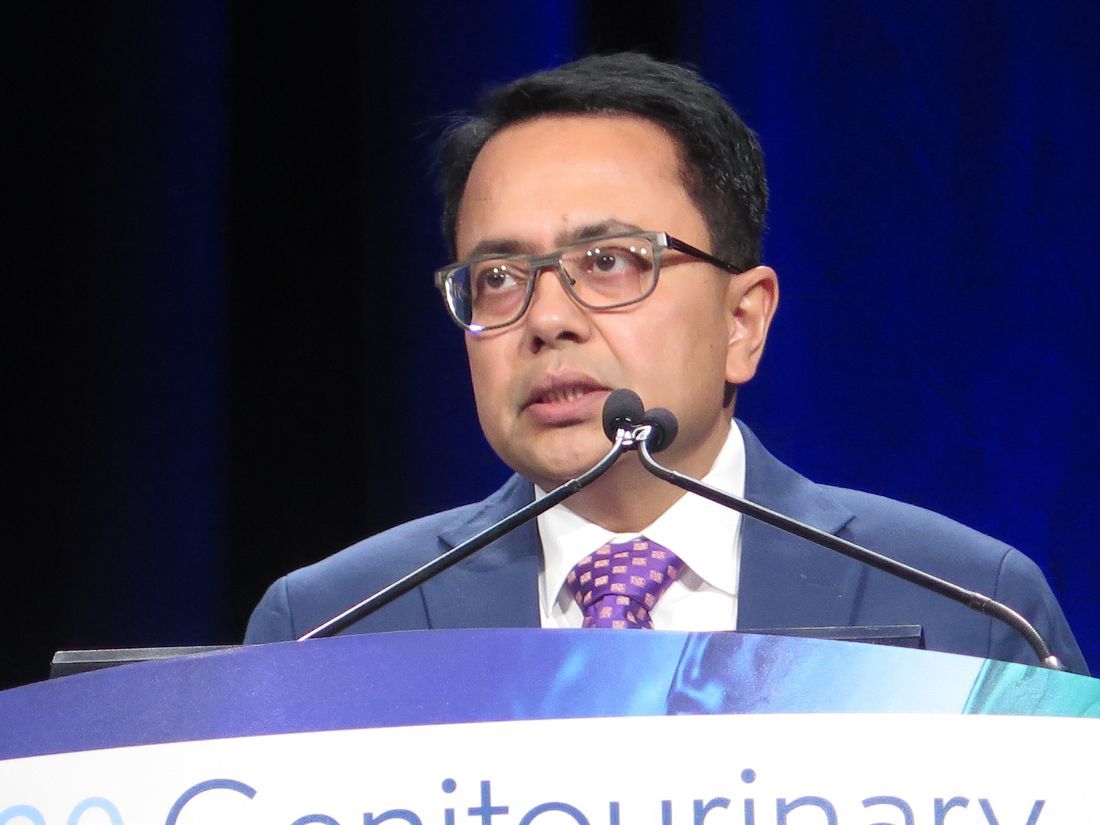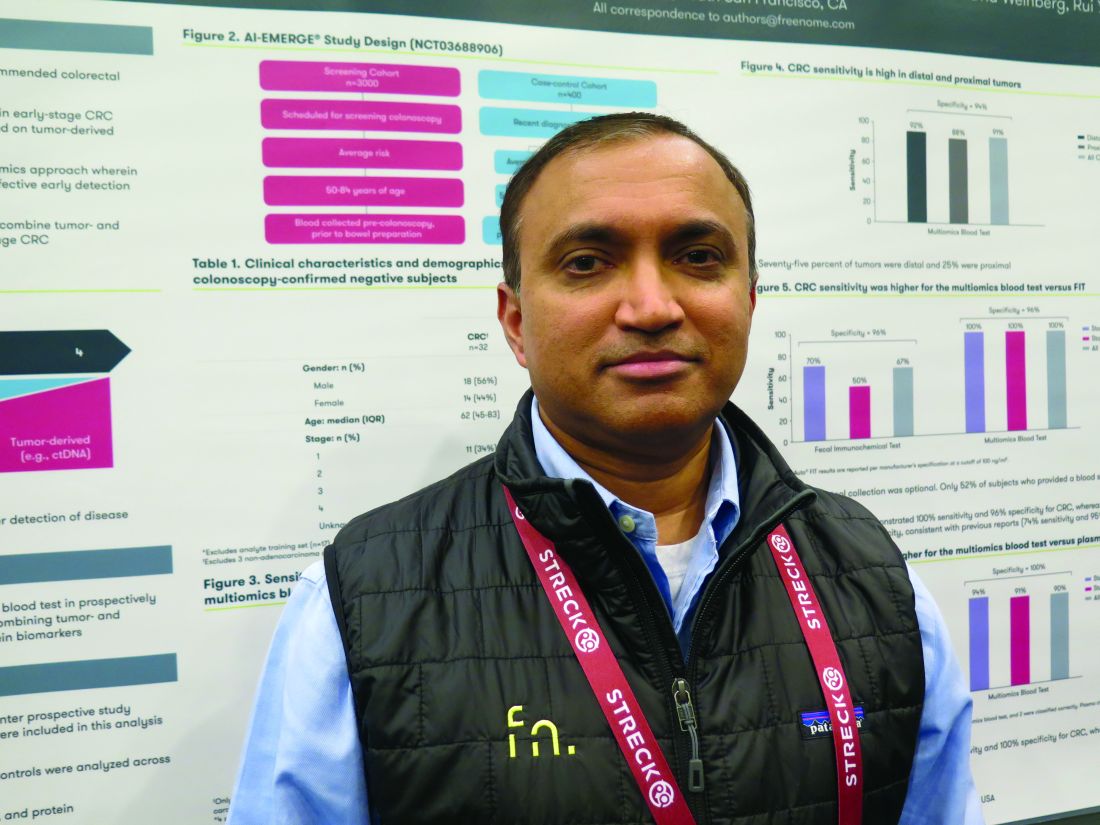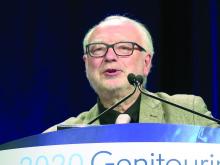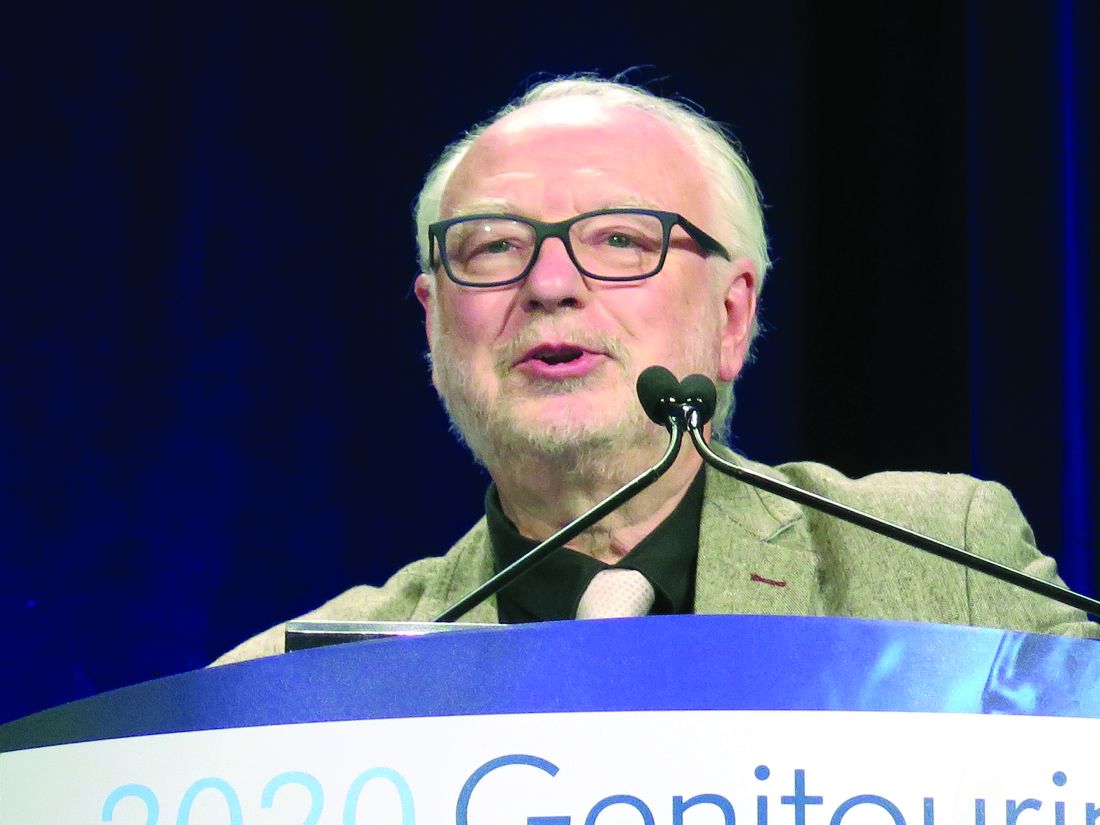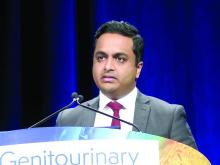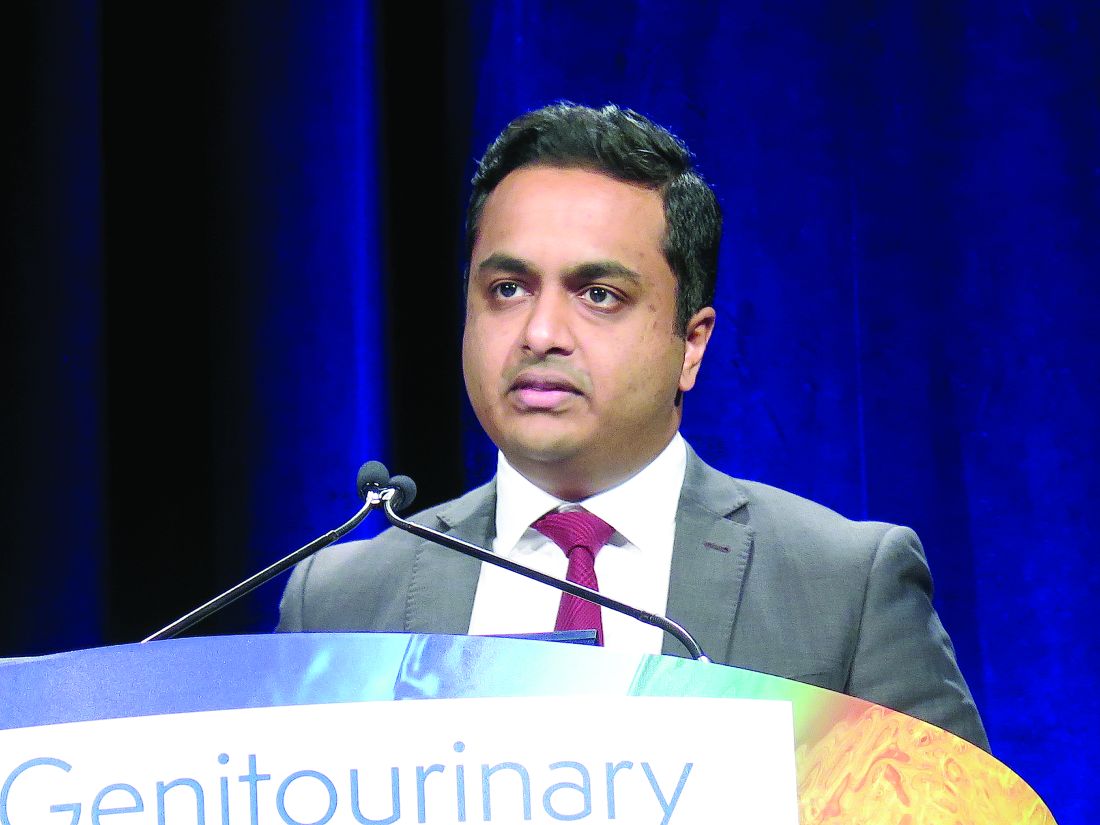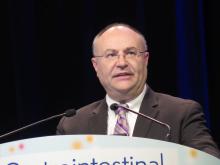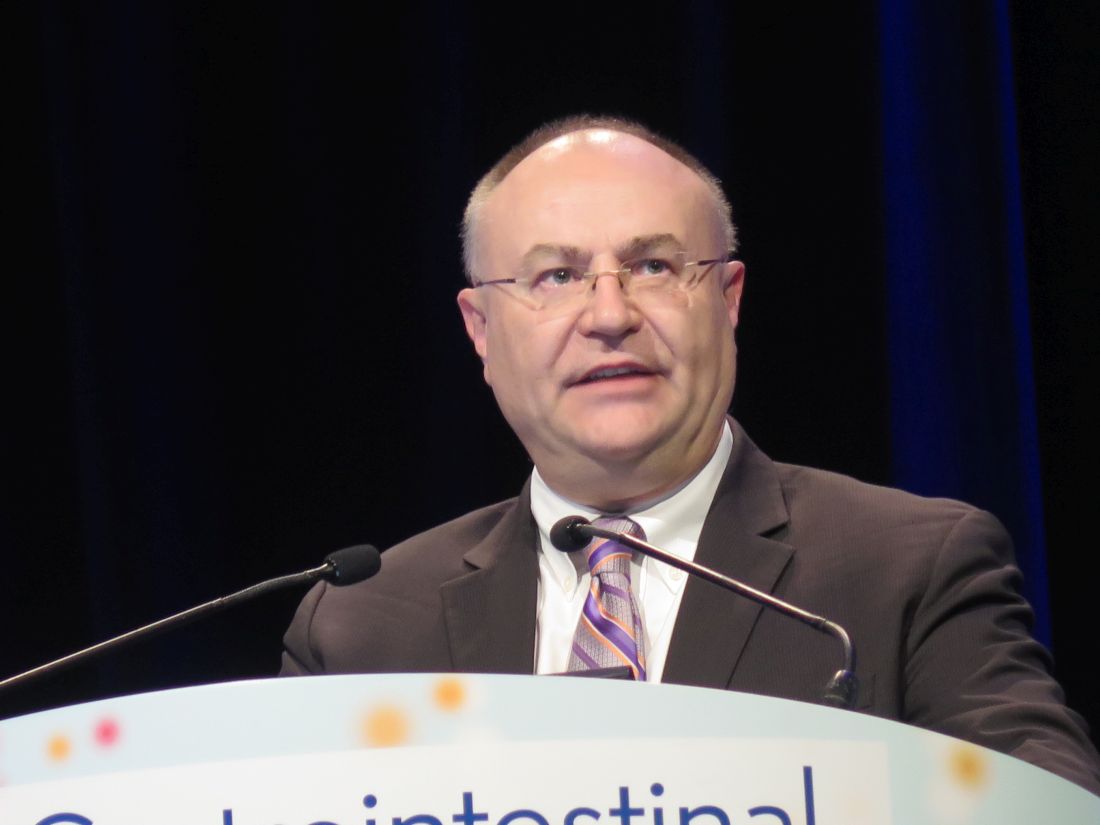User login
Gene therapy appears effective in bladder cancer patients with few options
SAN FRANCISCO – (BCG), new research suggests.
The therapy, nadofaragene firadenovec, is a recombinant adenovirus that is instilled into the bladder and delivers the human interferon alpha-2b gene, leading to expression of the immune cytokine.
At 3 months, nadofaragene firadenovec had produced a complete response in 53.4% of patients with carcinoma in situ (CIS), and the rate of high-grade recurrence-free survival was 59.6% in all patients. Although most patients (70.1%) experienced adverse events in this trial, few had serious events (1.9%).
Stephen A. Boorjian, MD, of the Mayo Clinic in Rochester, Minn., presented these results at the 2020 Genitourinary Cancers Symposium, sponsored by the American Society for Clinical Oncology, ASTRO, and the Society of Urologic Oncology.
“The optimal management for patients with BCG-unresponsive non–muscle invasive bladder cancer remains to be established,” Dr. Boorjian said. “National and organizational guidelines recommend radical cystectomy in this setting, but we have to acknowledge that many of our patients will be either unwilling or unfit to undergo what is often a highly morbid operation.”
Dr. Boorjian and coinvestigators tested nadofaragene firadenovec in 107 patients with CIS, with or without high-grade Ta or T1 papillary disease, as well as 50 patients with high-grade Ta or T1 papillary disease only.
All patients received nadofaragene firadenovec once every 3 months for up four doses, with additional dosing at the investigator’s discretion. Although the trial was designated as phase 3, it did not have the typical randomized comparative design.
“The challenge in the BCG-unresponsive disease state is that, historically, there has been no validated good comparator to use here; there’s no standard of care for these patients,” Dr. Boorjian explained, noting that the design was chosen after discussion with the Food and Drug Administration.
Efficacy
The complete response rate among CIS patients at any time after instillation, the trial’s primary objective, was 53.4%. All of these responses occurred after a single dose of nadofaragene firadenovec. Responses were considered durable, as 45.5% of CIS patients who had a complete response at 3 months still had a complete response at 12 months.
The rate of high-grade recurrence-free survival at 3 months was 59.6% in the overall population, 53.4% in patients with CIS, and 72.9% in patients with papillary disease. At 12 months, the rate of high-grade recurrence-free survival was 30.5%, 24.3%, and 43.8%, respectively.
The rate of high-grade recurrence without muscle invasive bladder cancer was 71.8% in the CIS group and 52.1% in the papillary group. The rate of progression to muscle invasive bladder cancer or more advanced disease was 4.9% and 6.3%, respectively. The overall 2-year rate of cystectomy-free survival was 64%, and there were no bladder cancer deaths.
Safety
Nadofaragene firadenovec was considered safe and well tolerated. The most common study drug–related adverse events were irritative voiding symptoms, such as discharge, bladder spasm, micturition urgency, and hematuria.
Although 70.1% of patients experienced a local or systemic adverse event related to the study drug or procedure, few experienced serious adverse events (1.9%), grade 3 adverse events (3.8%), or treatment-emergent adverse events leading to discontinuation (1.9%). The serious adverse events were sepsis, syncope, and hematuria.
Next steps
“Nadofaragene firadenovec represents a promising option for patients with BCG-unresponsive [non–muscle invasive bladder cancer],” Dr. Boorjian said. “What we want to see going forward is durability of response, cystectomy-free survival, and metastasis-free and cancer-specific survival. Those are the harder endpoints that, as these data mature, we will want to see so that we are able to counsel our patients accordingly.”
The FDA recently approved pembrolizumab for this patient population, noted session cochair Guru Sonpavde, MD, of the Dana-Farber Cancer Institute in Boston.
“But nadofaragene firadenovec is much less toxic, it is given intravesically, and it’s only given once every 3 months,” he said. “The outcomes at the 1-year point look similar in terms of the durable complete response rate. So we hope that this therapy will be able to get to the clinic, but we have to wait for the FDA to decide.”
It remains to be seen how nadofaragene firadenovec compares with other emerging therapies for high-risk BCG-unresponsive non–muscle invasive bladder cancer, including pembrolizumab and potentially intravesical oportuzumab monatox (a targeted immunotoxin) and intravesical combination BCG and superagonist interleukin-15 (ALT-803), according to Dr. Boorjian.
“A unique feature of the trial I presented was that the results were validated by a mandatory 12-month study biopsy, which has not been the case in other trials,” he pointed out. “So this separates it a little bit when you are looking at pathologic response rates and high-grade recurrence–free rates. They are based on pathologic confirmation.”
Evaluators will ultimately compare these therapies on safety, efficacy, ease of administration, delivery schedule, and cost, Dr. Boorjian said. “At this stage, it’s very difficult to start to say which agent is going to be placed where in our management paradigm. We have to go step by step: Do the trial that we did, show our data, put it out for review, and then allow the community to engage in a discussion about which agent, and why, for which patient.”
This trial was funded by FKD Therapies Oy. Dr. Boorjian disclosed relationships with Ferring and Sanofi. Dr. Sonpavde disclosed relationships with many companies.
SOURCE: Boorjian SA et al. GUCS 2020, Abstract 442.
SAN FRANCISCO – (BCG), new research suggests.
The therapy, nadofaragene firadenovec, is a recombinant adenovirus that is instilled into the bladder and delivers the human interferon alpha-2b gene, leading to expression of the immune cytokine.
At 3 months, nadofaragene firadenovec had produced a complete response in 53.4% of patients with carcinoma in situ (CIS), and the rate of high-grade recurrence-free survival was 59.6% in all patients. Although most patients (70.1%) experienced adverse events in this trial, few had serious events (1.9%).
Stephen A. Boorjian, MD, of the Mayo Clinic in Rochester, Minn., presented these results at the 2020 Genitourinary Cancers Symposium, sponsored by the American Society for Clinical Oncology, ASTRO, and the Society of Urologic Oncology.
“The optimal management for patients with BCG-unresponsive non–muscle invasive bladder cancer remains to be established,” Dr. Boorjian said. “National and organizational guidelines recommend radical cystectomy in this setting, but we have to acknowledge that many of our patients will be either unwilling or unfit to undergo what is often a highly morbid operation.”
Dr. Boorjian and coinvestigators tested nadofaragene firadenovec in 107 patients with CIS, with or without high-grade Ta or T1 papillary disease, as well as 50 patients with high-grade Ta or T1 papillary disease only.
All patients received nadofaragene firadenovec once every 3 months for up four doses, with additional dosing at the investigator’s discretion. Although the trial was designated as phase 3, it did not have the typical randomized comparative design.
“The challenge in the BCG-unresponsive disease state is that, historically, there has been no validated good comparator to use here; there’s no standard of care for these patients,” Dr. Boorjian explained, noting that the design was chosen after discussion with the Food and Drug Administration.
Efficacy
The complete response rate among CIS patients at any time after instillation, the trial’s primary objective, was 53.4%. All of these responses occurred after a single dose of nadofaragene firadenovec. Responses were considered durable, as 45.5% of CIS patients who had a complete response at 3 months still had a complete response at 12 months.
The rate of high-grade recurrence-free survival at 3 months was 59.6% in the overall population, 53.4% in patients with CIS, and 72.9% in patients with papillary disease. At 12 months, the rate of high-grade recurrence-free survival was 30.5%, 24.3%, and 43.8%, respectively.
The rate of high-grade recurrence without muscle invasive bladder cancer was 71.8% in the CIS group and 52.1% in the papillary group. The rate of progression to muscle invasive bladder cancer or more advanced disease was 4.9% and 6.3%, respectively. The overall 2-year rate of cystectomy-free survival was 64%, and there were no bladder cancer deaths.
Safety
Nadofaragene firadenovec was considered safe and well tolerated. The most common study drug–related adverse events were irritative voiding symptoms, such as discharge, bladder spasm, micturition urgency, and hematuria.
Although 70.1% of patients experienced a local or systemic adverse event related to the study drug or procedure, few experienced serious adverse events (1.9%), grade 3 adverse events (3.8%), or treatment-emergent adverse events leading to discontinuation (1.9%). The serious adverse events were sepsis, syncope, and hematuria.
Next steps
“Nadofaragene firadenovec represents a promising option for patients with BCG-unresponsive [non–muscle invasive bladder cancer],” Dr. Boorjian said. “What we want to see going forward is durability of response, cystectomy-free survival, and metastasis-free and cancer-specific survival. Those are the harder endpoints that, as these data mature, we will want to see so that we are able to counsel our patients accordingly.”
The FDA recently approved pembrolizumab for this patient population, noted session cochair Guru Sonpavde, MD, of the Dana-Farber Cancer Institute in Boston.
“But nadofaragene firadenovec is much less toxic, it is given intravesically, and it’s only given once every 3 months,” he said. “The outcomes at the 1-year point look similar in terms of the durable complete response rate. So we hope that this therapy will be able to get to the clinic, but we have to wait for the FDA to decide.”
It remains to be seen how nadofaragene firadenovec compares with other emerging therapies for high-risk BCG-unresponsive non–muscle invasive bladder cancer, including pembrolizumab and potentially intravesical oportuzumab monatox (a targeted immunotoxin) and intravesical combination BCG and superagonist interleukin-15 (ALT-803), according to Dr. Boorjian.
“A unique feature of the trial I presented was that the results were validated by a mandatory 12-month study biopsy, which has not been the case in other trials,” he pointed out. “So this separates it a little bit when you are looking at pathologic response rates and high-grade recurrence–free rates. They are based on pathologic confirmation.”
Evaluators will ultimately compare these therapies on safety, efficacy, ease of administration, delivery schedule, and cost, Dr. Boorjian said. “At this stage, it’s very difficult to start to say which agent is going to be placed where in our management paradigm. We have to go step by step: Do the trial that we did, show our data, put it out for review, and then allow the community to engage in a discussion about which agent, and why, for which patient.”
This trial was funded by FKD Therapies Oy. Dr. Boorjian disclosed relationships with Ferring and Sanofi. Dr. Sonpavde disclosed relationships with many companies.
SOURCE: Boorjian SA et al. GUCS 2020, Abstract 442.
SAN FRANCISCO – (BCG), new research suggests.
The therapy, nadofaragene firadenovec, is a recombinant adenovirus that is instilled into the bladder and delivers the human interferon alpha-2b gene, leading to expression of the immune cytokine.
At 3 months, nadofaragene firadenovec had produced a complete response in 53.4% of patients with carcinoma in situ (CIS), and the rate of high-grade recurrence-free survival was 59.6% in all patients. Although most patients (70.1%) experienced adverse events in this trial, few had serious events (1.9%).
Stephen A. Boorjian, MD, of the Mayo Clinic in Rochester, Minn., presented these results at the 2020 Genitourinary Cancers Symposium, sponsored by the American Society for Clinical Oncology, ASTRO, and the Society of Urologic Oncology.
“The optimal management for patients with BCG-unresponsive non–muscle invasive bladder cancer remains to be established,” Dr. Boorjian said. “National and organizational guidelines recommend radical cystectomy in this setting, but we have to acknowledge that many of our patients will be either unwilling or unfit to undergo what is often a highly morbid operation.”
Dr. Boorjian and coinvestigators tested nadofaragene firadenovec in 107 patients with CIS, with or without high-grade Ta or T1 papillary disease, as well as 50 patients with high-grade Ta or T1 papillary disease only.
All patients received nadofaragene firadenovec once every 3 months for up four doses, with additional dosing at the investigator’s discretion. Although the trial was designated as phase 3, it did not have the typical randomized comparative design.
“The challenge in the BCG-unresponsive disease state is that, historically, there has been no validated good comparator to use here; there’s no standard of care for these patients,” Dr. Boorjian explained, noting that the design was chosen after discussion with the Food and Drug Administration.
Efficacy
The complete response rate among CIS patients at any time after instillation, the trial’s primary objective, was 53.4%. All of these responses occurred after a single dose of nadofaragene firadenovec. Responses were considered durable, as 45.5% of CIS patients who had a complete response at 3 months still had a complete response at 12 months.
The rate of high-grade recurrence-free survival at 3 months was 59.6% in the overall population, 53.4% in patients with CIS, and 72.9% in patients with papillary disease. At 12 months, the rate of high-grade recurrence-free survival was 30.5%, 24.3%, and 43.8%, respectively.
The rate of high-grade recurrence without muscle invasive bladder cancer was 71.8% in the CIS group and 52.1% in the papillary group. The rate of progression to muscle invasive bladder cancer or more advanced disease was 4.9% and 6.3%, respectively. The overall 2-year rate of cystectomy-free survival was 64%, and there were no bladder cancer deaths.
Safety
Nadofaragene firadenovec was considered safe and well tolerated. The most common study drug–related adverse events were irritative voiding symptoms, such as discharge, bladder spasm, micturition urgency, and hematuria.
Although 70.1% of patients experienced a local or systemic adverse event related to the study drug or procedure, few experienced serious adverse events (1.9%), grade 3 adverse events (3.8%), or treatment-emergent adverse events leading to discontinuation (1.9%). The serious adverse events were sepsis, syncope, and hematuria.
Next steps
“Nadofaragene firadenovec represents a promising option for patients with BCG-unresponsive [non–muscle invasive bladder cancer],” Dr. Boorjian said. “What we want to see going forward is durability of response, cystectomy-free survival, and metastasis-free and cancer-specific survival. Those are the harder endpoints that, as these data mature, we will want to see so that we are able to counsel our patients accordingly.”
The FDA recently approved pembrolizumab for this patient population, noted session cochair Guru Sonpavde, MD, of the Dana-Farber Cancer Institute in Boston.
“But nadofaragene firadenovec is much less toxic, it is given intravesically, and it’s only given once every 3 months,” he said. “The outcomes at the 1-year point look similar in terms of the durable complete response rate. So we hope that this therapy will be able to get to the clinic, but we have to wait for the FDA to decide.”
It remains to be seen how nadofaragene firadenovec compares with other emerging therapies for high-risk BCG-unresponsive non–muscle invasive bladder cancer, including pembrolizumab and potentially intravesical oportuzumab monatox (a targeted immunotoxin) and intravesical combination BCG and superagonist interleukin-15 (ALT-803), according to Dr. Boorjian.
“A unique feature of the trial I presented was that the results were validated by a mandatory 12-month study biopsy, which has not been the case in other trials,” he pointed out. “So this separates it a little bit when you are looking at pathologic response rates and high-grade recurrence–free rates. They are based on pathologic confirmation.”
Evaluators will ultimately compare these therapies on safety, efficacy, ease of administration, delivery schedule, and cost, Dr. Boorjian said. “At this stage, it’s very difficult to start to say which agent is going to be placed where in our management paradigm. We have to go step by step: Do the trial that we did, show our data, put it out for review, and then allow the community to engage in a discussion about which agent, and why, for which patient.”
This trial was funded by FKD Therapies Oy. Dr. Boorjian disclosed relationships with Ferring and Sanofi. Dr. Sonpavde disclosed relationships with many companies.
SOURCE: Boorjian SA et al. GUCS 2020, Abstract 442.
REPORTING FROM GUCS 2020
Apalutamide benefit sustained in mCSPC regardless of next therapy
SAN FRANCISCO – , an exploratory analysis of the TITAN trial suggests.
Previous trial results for all 1,052 men randomized showed significant improvements in radiographic progression-free survival and overall survival from adding apalutamide versus placebo to androgen deprivation therapy (N Engl J Med. 2019;381:13-24), leading to recent Food and Drug Administration approval of the drug for metastatic castration-sensitive prostate cancer.
In the new analysis, investigators assessed progression-free survival 2 (PFS2), measured from time of randomization to investigator-determined disease progression or death, among the 277 men who went on to receive a subsequent life-prolonging therapy after progression on their trial therapy.
Results reported at the 2020 Genitourinary Cancers Symposium showed that the risk of PFS2 events was similarly reduced for patients who had initially received apalutamide vs. placebo regardless of whether their next therapy was a new hormonal therapy (32% reduction in risk) or a taxane (37% reduction in risk).
“The PFS2 benefit is an indicator of effective early intensification of treatment, is consistent with the overall survival benefit we have seen with this agent, and together shows totality of the treatment trajectory,” reported Neeraj Agarwal, MD, the study’s lead investigator. “These results may assist with counseling of patients with metastatic castration-sensitive prostate cancer who are contemplating various treatment options.”
The analysis was performed post hoc, and the subsequent therapy was left up to the treating clinicians, acknowledged Dr. Agarwal, professor of medicine and director of the genitourinary oncology program at the Huntsman Cancer Institute, University of Utah, Salt Lake City.
“A small number of events on subsequent therapy and the nonrandomized treatment decision preclude determination of best subsequent therapy based on these data,” he said. “We need further events and for data to mature more in order to pursue additional in-depth analysis.”
Some caveats
As only about a fifth of patients experienced PFS2 events, “these findings need to be interpreted with some caution,” said invited discussant Dana E. Rathkopf, MD, a genitourinary medical oncologist at Memorial Sloan Kettering Cancer Center in New York.
Another caveat is that the cohort analyzed comprised poor responders, who had experienced progression at a median of roughly 12 months whether on apalutamide or placebo, she noted. “If the patients were all on treatment for about 12 months, it does make me wonder why the apalutamide patients responded better than placebo patients to a second hormonal therapy, because you might think that, in the setting of poor response to upfront apalutamide, these patients may develop some type of intrinsic resistance that would suggest they would not respond to a second-line androgen receptor inhibitor relative to a taxane.”
Patients in TITAN were stratified on prior receipt of docetaxel before undergoing randomization. But simply by chance, among those receiving subsequent hormonal therapy, a larger share of those initially treated with apalutamide than of those initially treated with placebo had received the taxane (33% vs. 16%), which may have influenced outcomes, Dr. Rathkopf added.
“Further maturation of the data will tell us more,” she said. “But clearly, apalutamide in both the SPARTAN and TITAN trials improved PFS2 relative to placebo, and this begs the question of how we can better select treatment using predictive markers.”
Study details
Among the 277 men experiencing progression on their trial therapy and going on to receive a life-prolonging subsequent therapy, about 30% later received a new hormonal therapy – abiraterone or enzalutamide – and 35% subsequently received a taxane – docetaxel or cabazitaxel.
Overall, PFS2 was significantly better for men initially randomized to apalutamide, compared with counterparts initially randomized to placebo (hazard ratio for events, 0.66; P = .0026), Dr. Agarwal reported at the symposium, which was sponsored by the American Society of Clinical Oncology, ASTRO, and the Society of Urologic Oncology.
In stratified analyses, PFS2 was also significantly better with initial apalutamide vs. placebo whether patients went on to receive a new hormonal therapy (hazard ratio for events, 0.684; P = .0326) or taxane chemotherapy (hazard ratio for events, 0.634; P = .0062). Median values were not reached.
The trial was funded by Janssen Research & Development. Dr. Agarwal and Dr. Rathkopf each disclosed relationships with numerous pharmaceutical companies, including Janssen.
SOURCE: Agarwal N et al. GUCS 2020. Abstract 82.
SAN FRANCISCO – , an exploratory analysis of the TITAN trial suggests.
Previous trial results for all 1,052 men randomized showed significant improvements in radiographic progression-free survival and overall survival from adding apalutamide versus placebo to androgen deprivation therapy (N Engl J Med. 2019;381:13-24), leading to recent Food and Drug Administration approval of the drug for metastatic castration-sensitive prostate cancer.
In the new analysis, investigators assessed progression-free survival 2 (PFS2), measured from time of randomization to investigator-determined disease progression or death, among the 277 men who went on to receive a subsequent life-prolonging therapy after progression on their trial therapy.
Results reported at the 2020 Genitourinary Cancers Symposium showed that the risk of PFS2 events was similarly reduced for patients who had initially received apalutamide vs. placebo regardless of whether their next therapy was a new hormonal therapy (32% reduction in risk) or a taxane (37% reduction in risk).
“The PFS2 benefit is an indicator of effective early intensification of treatment, is consistent with the overall survival benefit we have seen with this agent, and together shows totality of the treatment trajectory,” reported Neeraj Agarwal, MD, the study’s lead investigator. “These results may assist with counseling of patients with metastatic castration-sensitive prostate cancer who are contemplating various treatment options.”
The analysis was performed post hoc, and the subsequent therapy was left up to the treating clinicians, acknowledged Dr. Agarwal, professor of medicine and director of the genitourinary oncology program at the Huntsman Cancer Institute, University of Utah, Salt Lake City.
“A small number of events on subsequent therapy and the nonrandomized treatment decision preclude determination of best subsequent therapy based on these data,” he said. “We need further events and for data to mature more in order to pursue additional in-depth analysis.”
Some caveats
As only about a fifth of patients experienced PFS2 events, “these findings need to be interpreted with some caution,” said invited discussant Dana E. Rathkopf, MD, a genitourinary medical oncologist at Memorial Sloan Kettering Cancer Center in New York.
Another caveat is that the cohort analyzed comprised poor responders, who had experienced progression at a median of roughly 12 months whether on apalutamide or placebo, she noted. “If the patients were all on treatment for about 12 months, it does make me wonder why the apalutamide patients responded better than placebo patients to a second hormonal therapy, because you might think that, in the setting of poor response to upfront apalutamide, these patients may develop some type of intrinsic resistance that would suggest they would not respond to a second-line androgen receptor inhibitor relative to a taxane.”
Patients in TITAN were stratified on prior receipt of docetaxel before undergoing randomization. But simply by chance, among those receiving subsequent hormonal therapy, a larger share of those initially treated with apalutamide than of those initially treated with placebo had received the taxane (33% vs. 16%), which may have influenced outcomes, Dr. Rathkopf added.
“Further maturation of the data will tell us more,” she said. “But clearly, apalutamide in both the SPARTAN and TITAN trials improved PFS2 relative to placebo, and this begs the question of how we can better select treatment using predictive markers.”
Study details
Among the 277 men experiencing progression on their trial therapy and going on to receive a life-prolonging subsequent therapy, about 30% later received a new hormonal therapy – abiraterone or enzalutamide – and 35% subsequently received a taxane – docetaxel or cabazitaxel.
Overall, PFS2 was significantly better for men initially randomized to apalutamide, compared with counterparts initially randomized to placebo (hazard ratio for events, 0.66; P = .0026), Dr. Agarwal reported at the symposium, which was sponsored by the American Society of Clinical Oncology, ASTRO, and the Society of Urologic Oncology.
In stratified analyses, PFS2 was also significantly better with initial apalutamide vs. placebo whether patients went on to receive a new hormonal therapy (hazard ratio for events, 0.684; P = .0326) or taxane chemotherapy (hazard ratio for events, 0.634; P = .0062). Median values were not reached.
The trial was funded by Janssen Research & Development. Dr. Agarwal and Dr. Rathkopf each disclosed relationships with numerous pharmaceutical companies, including Janssen.
SOURCE: Agarwal N et al. GUCS 2020. Abstract 82.
SAN FRANCISCO – , an exploratory analysis of the TITAN trial suggests.
Previous trial results for all 1,052 men randomized showed significant improvements in radiographic progression-free survival and overall survival from adding apalutamide versus placebo to androgen deprivation therapy (N Engl J Med. 2019;381:13-24), leading to recent Food and Drug Administration approval of the drug for metastatic castration-sensitive prostate cancer.
In the new analysis, investigators assessed progression-free survival 2 (PFS2), measured from time of randomization to investigator-determined disease progression or death, among the 277 men who went on to receive a subsequent life-prolonging therapy after progression on their trial therapy.
Results reported at the 2020 Genitourinary Cancers Symposium showed that the risk of PFS2 events was similarly reduced for patients who had initially received apalutamide vs. placebo regardless of whether their next therapy was a new hormonal therapy (32% reduction in risk) or a taxane (37% reduction in risk).
“The PFS2 benefit is an indicator of effective early intensification of treatment, is consistent with the overall survival benefit we have seen with this agent, and together shows totality of the treatment trajectory,” reported Neeraj Agarwal, MD, the study’s lead investigator. “These results may assist with counseling of patients with metastatic castration-sensitive prostate cancer who are contemplating various treatment options.”
The analysis was performed post hoc, and the subsequent therapy was left up to the treating clinicians, acknowledged Dr. Agarwal, professor of medicine and director of the genitourinary oncology program at the Huntsman Cancer Institute, University of Utah, Salt Lake City.
“A small number of events on subsequent therapy and the nonrandomized treatment decision preclude determination of best subsequent therapy based on these data,” he said. “We need further events and for data to mature more in order to pursue additional in-depth analysis.”
Some caveats
As only about a fifth of patients experienced PFS2 events, “these findings need to be interpreted with some caution,” said invited discussant Dana E. Rathkopf, MD, a genitourinary medical oncologist at Memorial Sloan Kettering Cancer Center in New York.
Another caveat is that the cohort analyzed comprised poor responders, who had experienced progression at a median of roughly 12 months whether on apalutamide or placebo, she noted. “If the patients were all on treatment for about 12 months, it does make me wonder why the apalutamide patients responded better than placebo patients to a second hormonal therapy, because you might think that, in the setting of poor response to upfront apalutamide, these patients may develop some type of intrinsic resistance that would suggest they would not respond to a second-line androgen receptor inhibitor relative to a taxane.”
Patients in TITAN were stratified on prior receipt of docetaxel before undergoing randomization. But simply by chance, among those receiving subsequent hormonal therapy, a larger share of those initially treated with apalutamide than of those initially treated with placebo had received the taxane (33% vs. 16%), which may have influenced outcomes, Dr. Rathkopf added.
“Further maturation of the data will tell us more,” she said. “But clearly, apalutamide in both the SPARTAN and TITAN trials improved PFS2 relative to placebo, and this begs the question of how we can better select treatment using predictive markers.”
Study details
Among the 277 men experiencing progression on their trial therapy and going on to receive a life-prolonging subsequent therapy, about 30% later received a new hormonal therapy – abiraterone or enzalutamide – and 35% subsequently received a taxane – docetaxel or cabazitaxel.
Overall, PFS2 was significantly better for men initially randomized to apalutamide, compared with counterparts initially randomized to placebo (hazard ratio for events, 0.66; P = .0026), Dr. Agarwal reported at the symposium, which was sponsored by the American Society of Clinical Oncology, ASTRO, and the Society of Urologic Oncology.
In stratified analyses, PFS2 was also significantly better with initial apalutamide vs. placebo whether patients went on to receive a new hormonal therapy (hazard ratio for events, 0.684; P = .0326) or taxane chemotherapy (hazard ratio for events, 0.634; P = .0062). Median values were not reached.
The trial was funded by Janssen Research & Development. Dr. Agarwal and Dr. Rathkopf each disclosed relationships with numerous pharmaceutical companies, including Janssen.
SOURCE: Agarwal N et al. GUCS 2020. Abstract 82.
REPORTING FROM GUCS 2020
Seminoma: Risk-adapted strategy could mean less toxic chemo
SAN FRANCISCO – with its toxicity. This was among key findings of the phase 2 SEMITEP trial reported at the 2020 Genitourinary Cancers Symposium.
Although four cycles of etoposide-cisplatin cure almost all cases of good-prognosis metastatic seminoma (Eur Urol. 2014;65:381-6), long-term cisplatin toxicity in this predominantly young population remains problematic, noted lead investigator Yohann Loriot, MD, PhD, a medical oncologist at Gustave Roussy Institute, Villejuif, France.
In SEMITEP, he and his colleagues tested a risk-adapted strategy among 98 patients with metastatic seminoma who met International Germ Cell Cancer Collaboration Group criteria for good prognosis and had not received any chemotherapy or radiotherapy.
Fully 68.4% had a negative FDG-PET result after two cycles of etoposide-cisplatin and were given only one cycle of carboplatin to complete treatment (based on that drug’s activity in low-volume disease), Dr. Loriot reported. The rest went on to receive an additional two cycles of etoposide-cisplatin, completing the standard regimen.
At 3 years, 9 in 10 patients were alive and free of progression in both the deescalated chemotherapy group and the standard chemotherapy group. The cumulative incidence of peripheral neuropathy, however, was about 10 times higher in the standard chemotherapy group.
“Deescalating chemotherapy based on an early FDG-PET is safe and feasible in metastatic seminoma,” Dr. Loriot said. “This strategy provides shorter treatment, reduces neuropathy, and eliminates need for bleomycin and its associated toxicity. SEMITEP supports the deescalating strategy in metastatic seminoma.”
Ready for prime time?
The SEMITEP trial achieved the main goal of reducing toxicity but had several noteworthy caveats, according to invited discussant Peter Albers, MD, professor and chairman of the department of urology, Heinrich-Heine University Düsseldorf, Germany.
First, in an “astonishing” feat, FDG-PET was performed and evaluable after just two cycles of chemotherapy, or 3 weeks, when typical practice is to wait until 8 or 10 weeks, he said.
“Second, I really don’t understand why carboplatin was given in an FDG-PET–negative seminoma,” Dr. Albers said. “There is, in my view, no reason to add another chemotherapy agent to this patient population if you really claim this to be a biomarker. Carboplatin is known to be inferior to cisplatin in metastatic seminoma.”
Third, enrolled patients predominantly had low-volume disease, with about two-thirds having clinical stage IIA or IIB. “So this study is not representative for all metastatic seminoma patients,” Dr. Albers cautioned. “But obviously, it gives a good signal, and those patients who had IIC disease in the deescalation arm have shown no recurrences so far.
“This trial is important and obviously accurately done, but to my mind, it’s not yet practice-changing. We need a clear comparison to standard treatment before we introduce FDG-PET as a biomarker in this indication,” he concluded, recommending that, for now, risk-stratified approaches should be limited to clinical trials.
Study details
Although 72% of patients in SEMITEP had a negative early FDG-PET result, four of them requested standard chemotherapy anyway and were analyzed in that group, Dr. Loriot noted at the symposium, which was sponsored by the American Society of Clinical Oncology, ASTRO, and the Society of Urologic Oncology.
With a median follow-up of 33.9 months, the 36-month rate of progression-free survival was 89.9% in the deescalated chemotherapy group, essentially the same as the 90% in the standard chemotherapy group. There were no deaths during follow-up in either group.
During chemotherapy, the deescalation group had lower rates of grade 3 or 4 nausea and vomiting and ototoxicity, and a higher rate of grade 3 or 4 thrombocytopenia.
At 3 years, the cumulative incidence of any-grade peripheral neuropathy was less than 5% in the deescalated chemotherapy group, compared with about 50% in the standard chemotherapy group (P less than .001). There was also a trend toward a lower incidence of ototoxicity with deescalation.
The trial was funded by Institut National du Cancer (Programme Hospitalier de Recherche Clinique). Dr. Loriot disclosed no relevant conflicts of interest. Dr. Albers disclosed relationships with Sanofi, Roche, and Merck Sharp & Dohme Corp.
SOURCE: Loriot Y et al. GUCS 2020. Abstract 387.
SAN FRANCISCO – with its toxicity. This was among key findings of the phase 2 SEMITEP trial reported at the 2020 Genitourinary Cancers Symposium.
Although four cycles of etoposide-cisplatin cure almost all cases of good-prognosis metastatic seminoma (Eur Urol. 2014;65:381-6), long-term cisplatin toxicity in this predominantly young population remains problematic, noted lead investigator Yohann Loriot, MD, PhD, a medical oncologist at Gustave Roussy Institute, Villejuif, France.
In SEMITEP, he and his colleagues tested a risk-adapted strategy among 98 patients with metastatic seminoma who met International Germ Cell Cancer Collaboration Group criteria for good prognosis and had not received any chemotherapy or radiotherapy.
Fully 68.4% had a negative FDG-PET result after two cycles of etoposide-cisplatin and were given only one cycle of carboplatin to complete treatment (based on that drug’s activity in low-volume disease), Dr. Loriot reported. The rest went on to receive an additional two cycles of etoposide-cisplatin, completing the standard regimen.
At 3 years, 9 in 10 patients were alive and free of progression in both the deescalated chemotherapy group and the standard chemotherapy group. The cumulative incidence of peripheral neuropathy, however, was about 10 times higher in the standard chemotherapy group.
“Deescalating chemotherapy based on an early FDG-PET is safe and feasible in metastatic seminoma,” Dr. Loriot said. “This strategy provides shorter treatment, reduces neuropathy, and eliminates need for bleomycin and its associated toxicity. SEMITEP supports the deescalating strategy in metastatic seminoma.”
Ready for prime time?
The SEMITEP trial achieved the main goal of reducing toxicity but had several noteworthy caveats, according to invited discussant Peter Albers, MD, professor and chairman of the department of urology, Heinrich-Heine University Düsseldorf, Germany.
First, in an “astonishing” feat, FDG-PET was performed and evaluable after just two cycles of chemotherapy, or 3 weeks, when typical practice is to wait until 8 or 10 weeks, he said.
“Second, I really don’t understand why carboplatin was given in an FDG-PET–negative seminoma,” Dr. Albers said. “There is, in my view, no reason to add another chemotherapy agent to this patient population if you really claim this to be a biomarker. Carboplatin is known to be inferior to cisplatin in metastatic seminoma.”
Third, enrolled patients predominantly had low-volume disease, with about two-thirds having clinical stage IIA or IIB. “So this study is not representative for all metastatic seminoma patients,” Dr. Albers cautioned. “But obviously, it gives a good signal, and those patients who had IIC disease in the deescalation arm have shown no recurrences so far.
“This trial is important and obviously accurately done, but to my mind, it’s not yet practice-changing. We need a clear comparison to standard treatment before we introduce FDG-PET as a biomarker in this indication,” he concluded, recommending that, for now, risk-stratified approaches should be limited to clinical trials.
Study details
Although 72% of patients in SEMITEP had a negative early FDG-PET result, four of them requested standard chemotherapy anyway and were analyzed in that group, Dr. Loriot noted at the symposium, which was sponsored by the American Society of Clinical Oncology, ASTRO, and the Society of Urologic Oncology.
With a median follow-up of 33.9 months, the 36-month rate of progression-free survival was 89.9% in the deescalated chemotherapy group, essentially the same as the 90% in the standard chemotherapy group. There were no deaths during follow-up in either group.
During chemotherapy, the deescalation group had lower rates of grade 3 or 4 nausea and vomiting and ototoxicity, and a higher rate of grade 3 or 4 thrombocytopenia.
At 3 years, the cumulative incidence of any-grade peripheral neuropathy was less than 5% in the deescalated chemotherapy group, compared with about 50% in the standard chemotherapy group (P less than .001). There was also a trend toward a lower incidence of ototoxicity with deescalation.
The trial was funded by Institut National du Cancer (Programme Hospitalier de Recherche Clinique). Dr. Loriot disclosed no relevant conflicts of interest. Dr. Albers disclosed relationships with Sanofi, Roche, and Merck Sharp & Dohme Corp.
SOURCE: Loriot Y et al. GUCS 2020. Abstract 387.
SAN FRANCISCO – with its toxicity. This was among key findings of the phase 2 SEMITEP trial reported at the 2020 Genitourinary Cancers Symposium.
Although four cycles of etoposide-cisplatin cure almost all cases of good-prognosis metastatic seminoma (Eur Urol. 2014;65:381-6), long-term cisplatin toxicity in this predominantly young population remains problematic, noted lead investigator Yohann Loriot, MD, PhD, a medical oncologist at Gustave Roussy Institute, Villejuif, France.
In SEMITEP, he and his colleagues tested a risk-adapted strategy among 98 patients with metastatic seminoma who met International Germ Cell Cancer Collaboration Group criteria for good prognosis and had not received any chemotherapy or radiotherapy.
Fully 68.4% had a negative FDG-PET result after two cycles of etoposide-cisplatin and were given only one cycle of carboplatin to complete treatment (based on that drug’s activity in low-volume disease), Dr. Loriot reported. The rest went on to receive an additional two cycles of etoposide-cisplatin, completing the standard regimen.
At 3 years, 9 in 10 patients were alive and free of progression in both the deescalated chemotherapy group and the standard chemotherapy group. The cumulative incidence of peripheral neuropathy, however, was about 10 times higher in the standard chemotherapy group.
“Deescalating chemotherapy based on an early FDG-PET is safe and feasible in metastatic seminoma,” Dr. Loriot said. “This strategy provides shorter treatment, reduces neuropathy, and eliminates need for bleomycin and its associated toxicity. SEMITEP supports the deescalating strategy in metastatic seminoma.”
Ready for prime time?
The SEMITEP trial achieved the main goal of reducing toxicity but had several noteworthy caveats, according to invited discussant Peter Albers, MD, professor and chairman of the department of urology, Heinrich-Heine University Düsseldorf, Germany.
First, in an “astonishing” feat, FDG-PET was performed and evaluable after just two cycles of chemotherapy, or 3 weeks, when typical practice is to wait until 8 or 10 weeks, he said.
“Second, I really don’t understand why carboplatin was given in an FDG-PET–negative seminoma,” Dr. Albers said. “There is, in my view, no reason to add another chemotherapy agent to this patient population if you really claim this to be a biomarker. Carboplatin is known to be inferior to cisplatin in metastatic seminoma.”
Third, enrolled patients predominantly had low-volume disease, with about two-thirds having clinical stage IIA or IIB. “So this study is not representative for all metastatic seminoma patients,” Dr. Albers cautioned. “But obviously, it gives a good signal, and those patients who had IIC disease in the deescalation arm have shown no recurrences so far.
“This trial is important and obviously accurately done, but to my mind, it’s not yet practice-changing. We need a clear comparison to standard treatment before we introduce FDG-PET as a biomarker in this indication,” he concluded, recommending that, for now, risk-stratified approaches should be limited to clinical trials.
Study details
Although 72% of patients in SEMITEP had a negative early FDG-PET result, four of them requested standard chemotherapy anyway and were analyzed in that group, Dr. Loriot noted at the symposium, which was sponsored by the American Society of Clinical Oncology, ASTRO, and the Society of Urologic Oncology.
With a median follow-up of 33.9 months, the 36-month rate of progression-free survival was 89.9% in the deescalated chemotherapy group, essentially the same as the 90% in the standard chemotherapy group. There were no deaths during follow-up in either group.
During chemotherapy, the deescalation group had lower rates of grade 3 or 4 nausea and vomiting and ototoxicity, and a higher rate of grade 3 or 4 thrombocytopenia.
At 3 years, the cumulative incidence of any-grade peripheral neuropathy was less than 5% in the deescalated chemotherapy group, compared with about 50% in the standard chemotherapy group (P less than .001). There was also a trend toward a lower incidence of ototoxicity with deescalation.
The trial was funded by Institut National du Cancer (Programme Hospitalier de Recherche Clinique). Dr. Loriot disclosed no relevant conflicts of interest. Dr. Albers disclosed relationships with Sanofi, Roche, and Merck Sharp & Dohme Corp.
SOURCE: Loriot Y et al. GUCS 2020. Abstract 387.
REPORTING FROM GUCS 2020
SBRT may boost efficacy of immunotherapy in renal cell carcinoma
SAN FRANCISCO – (RCC), results of the RADVAX RCC trial suggest.
More than half of patients (56%) who received SBRT plus nivolumab and ipilimumab achieved a response in nonirradiated lesions, but the prespecified threshold for efficacy was not met (70%). Still, the combination was active and well tolerated, and it warrants further investigation, according to Hans J. Hammers, MD, PhD, of the University of Texas, Dallas.
Dr. Hammers presented results from the RADVAX RCC trial at the 2020 Genitourinary Cancers Symposium sponsored by the American Society for Clinical Oncology, ASTRO, and the Society of Urologic Oncology.
Study details
The phase 2 trial enrolled 25 patients with metastatic clear-cell RCC. They had at least two metastatic sites, one of which was measurable for response. Forty percent had received at least one prior line of systemic therapy, and 30% had tumors positive for programmed death–ligand 1 expression. Almost a third had not undergone nephrectomy and therefore still had their primary tumor.
Patients received SBRT (50 Gy in five fractions) at one or two sites while also receiving nivolumab and ipilimumab. SBRT was given right after the first of four nivolumab-ipilimumab treatments and was delivered to lesions in the lung (56% of patients), lymph nodes (20%), bone or soft tissue (12%), and kidney (12%). Patients went on to receive maintenance nivolumab monotherapy.
At a median follow-up of 24 months, 56% of patients achieved a response in nonirradiated lesions. All were partial responses.
The 56% response rate fell short of the trial’s predefined efficacy endpoint of 70%. However, “we felt that an increase to around 60% [with the addition of SBRT] would probably be a reasonable signal for this small signal-finding study,” Dr. Hammers said, noting that this would be in line with the increase seen with intratumoral injections of immune stimulators.
“I would say we are not that far off if the numbers are real,” he added. “That certainly needs to be confirmed and expanded. And I’m sure we can make it more intelligent by choosing which tumors we go after because, right now, we are doing it completely blindly.”
The lack of any complete responses is likely explained, in part, by the large share of patients still having their primary tumor, Dr. Hammers said.
The median duration of response was not reached. The median progression-free survival was 8.21 months, and the median overall survival was not reached.
Thirty-six percent of patients experienced grade 3-4 adverse events, all gastrointestinal. Of the two patients (8%) experiencing grade 2 radiation pneumonitis, one was a case of radiation recall. Some patients needed high-dose corticosteroids (40%) and additional immune suppression (28%) for side effect management.
Should SBRT move forward in RCC?
“We feel that the combination of SBRT with dual immune checkpoint inhibition is feasible and associated with an acceptable safety profile,” Dr. Hammers said. “We do see an encouraging antitumor activity that we believe warrants further investigation.”
A proposed RADVAX II trial would assess programmed death–ligand 1 expression across tumor sites using PET. “We would then direct the radiation to the cold [noninflamed] tumors to derive potentially the maximum benefit in the sense of in situ vaccination,” Dr. Hammers explained.
Invited discussant Thomas Powles, MD, PhD, of the Barts Cancer Institute in London, questioned whether SBRT plus immunotherapy should move forward in RCC patients. He noted that the abscopal effect was first described in the 1950s, but evidence of its clinical efficacy remains limited and inconsistent.
“We are in an era where we are keen to believe that this [phenomenon] exists,” Dr. Powles said. “But just because we can do SBRT in our hospitals doesn’t mean we should be doing it without robust data. The robustness of this data in renal cancer is not there at the moment.”
The 56% response rate seen in the RADVAX RCC trial was somewhat better than the 42% response rate seen in the CheckMate 214 trial with nivolumab and ipilimumab alone among patients with metastatic RCC treated in the first-line setting (Lancet Oncol. 2019;20:1370-85), Dr. Powles noted, while acknowledging the limitations of a cross-trial comparison.
“[However,] there were no complete responses, and this is therefore not a home run, in my opinion,” he said. “Progression-free survival was modest. Clearly, tolerability was okay.”
“In this work, the null hypothesis has not been rejected,” he added. “That’s an English way of saying it didn’t work very well. The question I put to you is, if [SBRT and immunotherapy] were a drug combination, would we be taking it further in randomized trials? And I suspect the answer to that is probably no.”
This trial was funded by KidneyCAN. Dr. Hammers and Dr. Powles disclosed relationships with Bristol-Myers Squibb, which markets nivolumab and ipilimumab, as well as other companies.
SOURCE: Hammers HJ et al. GUCS 2020, Abstract 614.
SAN FRANCISCO – (RCC), results of the RADVAX RCC trial suggest.
More than half of patients (56%) who received SBRT plus nivolumab and ipilimumab achieved a response in nonirradiated lesions, but the prespecified threshold for efficacy was not met (70%). Still, the combination was active and well tolerated, and it warrants further investigation, according to Hans J. Hammers, MD, PhD, of the University of Texas, Dallas.
Dr. Hammers presented results from the RADVAX RCC trial at the 2020 Genitourinary Cancers Symposium sponsored by the American Society for Clinical Oncology, ASTRO, and the Society of Urologic Oncology.
Study details
The phase 2 trial enrolled 25 patients with metastatic clear-cell RCC. They had at least two metastatic sites, one of which was measurable for response. Forty percent had received at least one prior line of systemic therapy, and 30% had tumors positive for programmed death–ligand 1 expression. Almost a third had not undergone nephrectomy and therefore still had their primary tumor.
Patients received SBRT (50 Gy in five fractions) at one or two sites while also receiving nivolumab and ipilimumab. SBRT was given right after the first of four nivolumab-ipilimumab treatments and was delivered to lesions in the lung (56% of patients), lymph nodes (20%), bone or soft tissue (12%), and kidney (12%). Patients went on to receive maintenance nivolumab monotherapy.
At a median follow-up of 24 months, 56% of patients achieved a response in nonirradiated lesions. All were partial responses.
The 56% response rate fell short of the trial’s predefined efficacy endpoint of 70%. However, “we felt that an increase to around 60% [with the addition of SBRT] would probably be a reasonable signal for this small signal-finding study,” Dr. Hammers said, noting that this would be in line with the increase seen with intratumoral injections of immune stimulators.
“I would say we are not that far off if the numbers are real,” he added. “That certainly needs to be confirmed and expanded. And I’m sure we can make it more intelligent by choosing which tumors we go after because, right now, we are doing it completely blindly.”
The lack of any complete responses is likely explained, in part, by the large share of patients still having their primary tumor, Dr. Hammers said.
The median duration of response was not reached. The median progression-free survival was 8.21 months, and the median overall survival was not reached.
Thirty-six percent of patients experienced grade 3-4 adverse events, all gastrointestinal. Of the two patients (8%) experiencing grade 2 radiation pneumonitis, one was a case of radiation recall. Some patients needed high-dose corticosteroids (40%) and additional immune suppression (28%) for side effect management.
Should SBRT move forward in RCC?
“We feel that the combination of SBRT with dual immune checkpoint inhibition is feasible and associated with an acceptable safety profile,” Dr. Hammers said. “We do see an encouraging antitumor activity that we believe warrants further investigation.”
A proposed RADVAX II trial would assess programmed death–ligand 1 expression across tumor sites using PET. “We would then direct the radiation to the cold [noninflamed] tumors to derive potentially the maximum benefit in the sense of in situ vaccination,” Dr. Hammers explained.
Invited discussant Thomas Powles, MD, PhD, of the Barts Cancer Institute in London, questioned whether SBRT plus immunotherapy should move forward in RCC patients. He noted that the abscopal effect was first described in the 1950s, but evidence of its clinical efficacy remains limited and inconsistent.
“We are in an era where we are keen to believe that this [phenomenon] exists,” Dr. Powles said. “But just because we can do SBRT in our hospitals doesn’t mean we should be doing it without robust data. The robustness of this data in renal cancer is not there at the moment.”
The 56% response rate seen in the RADVAX RCC trial was somewhat better than the 42% response rate seen in the CheckMate 214 trial with nivolumab and ipilimumab alone among patients with metastatic RCC treated in the first-line setting (Lancet Oncol. 2019;20:1370-85), Dr. Powles noted, while acknowledging the limitations of a cross-trial comparison.
“[However,] there were no complete responses, and this is therefore not a home run, in my opinion,” he said. “Progression-free survival was modest. Clearly, tolerability was okay.”
“In this work, the null hypothesis has not been rejected,” he added. “That’s an English way of saying it didn’t work very well. The question I put to you is, if [SBRT and immunotherapy] were a drug combination, would we be taking it further in randomized trials? And I suspect the answer to that is probably no.”
This trial was funded by KidneyCAN. Dr. Hammers and Dr. Powles disclosed relationships with Bristol-Myers Squibb, which markets nivolumab and ipilimumab, as well as other companies.
SOURCE: Hammers HJ et al. GUCS 2020, Abstract 614.
SAN FRANCISCO – (RCC), results of the RADVAX RCC trial suggest.
More than half of patients (56%) who received SBRT plus nivolumab and ipilimumab achieved a response in nonirradiated lesions, but the prespecified threshold for efficacy was not met (70%). Still, the combination was active and well tolerated, and it warrants further investigation, according to Hans J. Hammers, MD, PhD, of the University of Texas, Dallas.
Dr. Hammers presented results from the RADVAX RCC trial at the 2020 Genitourinary Cancers Symposium sponsored by the American Society for Clinical Oncology, ASTRO, and the Society of Urologic Oncology.
Study details
The phase 2 trial enrolled 25 patients with metastatic clear-cell RCC. They had at least two metastatic sites, one of which was measurable for response. Forty percent had received at least one prior line of systemic therapy, and 30% had tumors positive for programmed death–ligand 1 expression. Almost a third had not undergone nephrectomy and therefore still had their primary tumor.
Patients received SBRT (50 Gy in five fractions) at one or two sites while also receiving nivolumab and ipilimumab. SBRT was given right after the first of four nivolumab-ipilimumab treatments and was delivered to lesions in the lung (56% of patients), lymph nodes (20%), bone or soft tissue (12%), and kidney (12%). Patients went on to receive maintenance nivolumab monotherapy.
At a median follow-up of 24 months, 56% of patients achieved a response in nonirradiated lesions. All were partial responses.
The 56% response rate fell short of the trial’s predefined efficacy endpoint of 70%. However, “we felt that an increase to around 60% [with the addition of SBRT] would probably be a reasonable signal for this small signal-finding study,” Dr. Hammers said, noting that this would be in line with the increase seen with intratumoral injections of immune stimulators.
“I would say we are not that far off if the numbers are real,” he added. “That certainly needs to be confirmed and expanded. And I’m sure we can make it more intelligent by choosing which tumors we go after because, right now, we are doing it completely blindly.”
The lack of any complete responses is likely explained, in part, by the large share of patients still having their primary tumor, Dr. Hammers said.
The median duration of response was not reached. The median progression-free survival was 8.21 months, and the median overall survival was not reached.
Thirty-six percent of patients experienced grade 3-4 adverse events, all gastrointestinal. Of the two patients (8%) experiencing grade 2 radiation pneumonitis, one was a case of radiation recall. Some patients needed high-dose corticosteroids (40%) and additional immune suppression (28%) for side effect management.
Should SBRT move forward in RCC?
“We feel that the combination of SBRT with dual immune checkpoint inhibition is feasible and associated with an acceptable safety profile,” Dr. Hammers said. “We do see an encouraging antitumor activity that we believe warrants further investigation.”
A proposed RADVAX II trial would assess programmed death–ligand 1 expression across tumor sites using PET. “We would then direct the radiation to the cold [noninflamed] tumors to derive potentially the maximum benefit in the sense of in situ vaccination,” Dr. Hammers explained.
Invited discussant Thomas Powles, MD, PhD, of the Barts Cancer Institute in London, questioned whether SBRT plus immunotherapy should move forward in RCC patients. He noted that the abscopal effect was first described in the 1950s, but evidence of its clinical efficacy remains limited and inconsistent.
“We are in an era where we are keen to believe that this [phenomenon] exists,” Dr. Powles said. “But just because we can do SBRT in our hospitals doesn’t mean we should be doing it without robust data. The robustness of this data in renal cancer is not there at the moment.”
The 56% response rate seen in the RADVAX RCC trial was somewhat better than the 42% response rate seen in the CheckMate 214 trial with nivolumab and ipilimumab alone among patients with metastatic RCC treated in the first-line setting (Lancet Oncol. 2019;20:1370-85), Dr. Powles noted, while acknowledging the limitations of a cross-trial comparison.
“[However,] there were no complete responses, and this is therefore not a home run, in my opinion,” he said. “Progression-free survival was modest. Clearly, tolerability was okay.”
“In this work, the null hypothesis has not been rejected,” he added. “That’s an English way of saying it didn’t work very well. The question I put to you is, if [SBRT and immunotherapy] were a drug combination, would we be taking it further in randomized trials? And I suspect the answer to that is probably no.”
This trial was funded by KidneyCAN. Dr. Hammers and Dr. Powles disclosed relationships with Bristol-Myers Squibb, which markets nivolumab and ipilimumab, as well as other companies.
SOURCE: Hammers HJ et al. GUCS 2020, Abstract 614.
REPORTING FROM GUCS 2020
Multiomics blood test outperforms others for CRC
SAN FRANCISCO – A blood-based test that integrates data from multiple molecular “omes,” such as the genome and proteome, performs well at spotting early-stage colorectal cancer (CRC), the AI-EMERGE study suggests.
Moreover, the test netted better sensitivity than a fecal immunochemical test (FIT), a circulating tumor DNA (ctDNA) test, and a carcinoembryonic antigen (CEA) test.
Findings were reported in a poster session at the 2020 GI Cancers Symposium, which is cosponsored by the American Gastroenterological Association, American Society of Clinical Oncology, American Society for Radiation Oncology, and Society of Surgical Oncology.
“Today, about a third of age-appropriate adults are not up to date with [CRC] screening,” lead study investigator Girish Putcha, MD, PhD, chief medical officer of Freenome in San Francisco, noted at the symposium. “A noninvasive blood-based screening test having high sensitivity and specificity for [CRC] generally, but especially for early-stage disease, could help improve adherence and ultimately reduce mortality.”
Dr. Putcha and colleagues evaluated a blood-based multiomics test in 32 patients with CRC of all stages and 539 colonoscopy-confirmed negative control subjects.
The test uses a multiomics platform to pick up both tumor-derived signal and non–tumor-derived signal from the body’s immune response and other sources. The test uses machine learning, and entails whole-genome sequencing, bisulfite sequencing (for assessment of DNA methylation), and protein quantification methods.
At 94% specificity, the test had a 94% sensitivity for spotting stage I and II CRC, 91% sensitivity for stage III and IV CRC, and 91% sensitivity for CRC of any stage. By location, sensitivity was 92% for distal tumors and 88% for proximal tumors.
The multiomics test outperformed a ctDNA test, a CEA test, and a FIT. At a specificity of 96% for both tests, the multiomics test yielded a higher sensitivity than a commercially available FIT stool test (OC-Auto FIT, Polymedco) for stage I and II disease (100% vs. 70%), stage III and IV disease (100% vs. 50%), and any-stage disease (100% vs. 67%).
When set at 100% specificity, the multiomics test outperformed a commercially available plasma ctDNA test (Avenio, Roche) set at 75% specificity. The multiomics test yielded a higher sensitivity for stage I and II disease (94% vs. 38%), stage III and IV disease (91% vs. 55%), and any-stage disease (90% vs. 47%).
At a specificity of 94% for both tests, the multiomics test yielded a higher sensitivity than plasma CEA level for stage I and II disease (94% vs. 18%), stage III and IV disease (91% vs. 45%), and any-stage disease (91% vs. 31%).
“Although there were many exciting aspects to this study, the test’s ability to detect cancers without loss of sensitivity for early-stage cancers was striking to me,” said Michael J. Hall, MD, of Fox Chase Cancer Center in Philadelphia, who was not involved in the study. “The loss of sensitivity in early tumors has been a limitation of other tests – FOBT [fecal occult blood test], FIT – so if this is replicable, this is exciting.”
Although the study was small for a CRC screening assessment, “the preliminary results presented in the poster were certainly compelling enough to support more research,” Dr. Hall said.
Dr. Putcha said that the test will be validated in a prospective, multicenter trial of roughly 10,000 participants at average risk, expected to open later this year. Further research will also help assess the test’s performance among patients with inflammatory bowel disease, for whom false-positive results with some screening tests have been problematic.
The study was sponsored by Freenome. Dr. Putcha is employed by Freenome and has a relationship with Palmetto GBA. Dr. Hall disclosed relationships with Ambry Genetics, AstraZeneca, Caris Life Sciences, Foundation Medicine, Invitae, and Myriad Genetics, and he shares a patent with institutional colleagues for a novel method to investigate hereditary CRC genes.
SOURCE: Putcha G et al. 2020 GI Cancers Symposium, Abstract 66.
Visit the AGA GI Patient Center for education to share with your patients about currently available CRC screenings at https://www.gastro.org/
SAN FRANCISCO – A blood-based test that integrates data from multiple molecular “omes,” such as the genome and proteome, performs well at spotting early-stage colorectal cancer (CRC), the AI-EMERGE study suggests.
Moreover, the test netted better sensitivity than a fecal immunochemical test (FIT), a circulating tumor DNA (ctDNA) test, and a carcinoembryonic antigen (CEA) test.
Findings were reported in a poster session at the 2020 GI Cancers Symposium, which is cosponsored by the American Gastroenterological Association, American Society of Clinical Oncology, American Society for Radiation Oncology, and Society of Surgical Oncology.
“Today, about a third of age-appropriate adults are not up to date with [CRC] screening,” lead study investigator Girish Putcha, MD, PhD, chief medical officer of Freenome in San Francisco, noted at the symposium. “A noninvasive blood-based screening test having high sensitivity and specificity for [CRC] generally, but especially for early-stage disease, could help improve adherence and ultimately reduce mortality.”
Dr. Putcha and colleagues evaluated a blood-based multiomics test in 32 patients with CRC of all stages and 539 colonoscopy-confirmed negative control subjects.
The test uses a multiomics platform to pick up both tumor-derived signal and non–tumor-derived signal from the body’s immune response and other sources. The test uses machine learning, and entails whole-genome sequencing, bisulfite sequencing (for assessment of DNA methylation), and protein quantification methods.
At 94% specificity, the test had a 94% sensitivity for spotting stage I and II CRC, 91% sensitivity for stage III and IV CRC, and 91% sensitivity for CRC of any stage. By location, sensitivity was 92% for distal tumors and 88% for proximal tumors.
The multiomics test outperformed a ctDNA test, a CEA test, and a FIT. At a specificity of 96% for both tests, the multiomics test yielded a higher sensitivity than a commercially available FIT stool test (OC-Auto FIT, Polymedco) for stage I and II disease (100% vs. 70%), stage III and IV disease (100% vs. 50%), and any-stage disease (100% vs. 67%).
When set at 100% specificity, the multiomics test outperformed a commercially available plasma ctDNA test (Avenio, Roche) set at 75% specificity. The multiomics test yielded a higher sensitivity for stage I and II disease (94% vs. 38%), stage III and IV disease (91% vs. 55%), and any-stage disease (90% vs. 47%).
At a specificity of 94% for both tests, the multiomics test yielded a higher sensitivity than plasma CEA level for stage I and II disease (94% vs. 18%), stage III and IV disease (91% vs. 45%), and any-stage disease (91% vs. 31%).
“Although there were many exciting aspects to this study, the test’s ability to detect cancers without loss of sensitivity for early-stage cancers was striking to me,” said Michael J. Hall, MD, of Fox Chase Cancer Center in Philadelphia, who was not involved in the study. “The loss of sensitivity in early tumors has been a limitation of other tests – FOBT [fecal occult blood test], FIT – so if this is replicable, this is exciting.”
Although the study was small for a CRC screening assessment, “the preliminary results presented in the poster were certainly compelling enough to support more research,” Dr. Hall said.
Dr. Putcha said that the test will be validated in a prospective, multicenter trial of roughly 10,000 participants at average risk, expected to open later this year. Further research will also help assess the test’s performance among patients with inflammatory bowel disease, for whom false-positive results with some screening tests have been problematic.
The study was sponsored by Freenome. Dr. Putcha is employed by Freenome and has a relationship with Palmetto GBA. Dr. Hall disclosed relationships with Ambry Genetics, AstraZeneca, Caris Life Sciences, Foundation Medicine, Invitae, and Myriad Genetics, and he shares a patent with institutional colleagues for a novel method to investigate hereditary CRC genes.
SOURCE: Putcha G et al. 2020 GI Cancers Symposium, Abstract 66.
Visit the AGA GI Patient Center for education to share with your patients about currently available CRC screenings at https://www.gastro.org/
SAN FRANCISCO – A blood-based test that integrates data from multiple molecular “omes,” such as the genome and proteome, performs well at spotting early-stage colorectal cancer (CRC), the AI-EMERGE study suggests.
Moreover, the test netted better sensitivity than a fecal immunochemical test (FIT), a circulating tumor DNA (ctDNA) test, and a carcinoembryonic antigen (CEA) test.
Findings were reported in a poster session at the 2020 GI Cancers Symposium, which is cosponsored by the American Gastroenterological Association, American Society of Clinical Oncology, American Society for Radiation Oncology, and Society of Surgical Oncology.
“Today, about a third of age-appropriate adults are not up to date with [CRC] screening,” lead study investigator Girish Putcha, MD, PhD, chief medical officer of Freenome in San Francisco, noted at the symposium. “A noninvasive blood-based screening test having high sensitivity and specificity for [CRC] generally, but especially for early-stage disease, could help improve adherence and ultimately reduce mortality.”
Dr. Putcha and colleagues evaluated a blood-based multiomics test in 32 patients with CRC of all stages and 539 colonoscopy-confirmed negative control subjects.
The test uses a multiomics platform to pick up both tumor-derived signal and non–tumor-derived signal from the body’s immune response and other sources. The test uses machine learning, and entails whole-genome sequencing, bisulfite sequencing (for assessment of DNA methylation), and protein quantification methods.
At 94% specificity, the test had a 94% sensitivity for spotting stage I and II CRC, 91% sensitivity for stage III and IV CRC, and 91% sensitivity for CRC of any stage. By location, sensitivity was 92% for distal tumors and 88% for proximal tumors.
The multiomics test outperformed a ctDNA test, a CEA test, and a FIT. At a specificity of 96% for both tests, the multiomics test yielded a higher sensitivity than a commercially available FIT stool test (OC-Auto FIT, Polymedco) for stage I and II disease (100% vs. 70%), stage III and IV disease (100% vs. 50%), and any-stage disease (100% vs. 67%).
When set at 100% specificity, the multiomics test outperformed a commercially available plasma ctDNA test (Avenio, Roche) set at 75% specificity. The multiomics test yielded a higher sensitivity for stage I and II disease (94% vs. 38%), stage III and IV disease (91% vs. 55%), and any-stage disease (90% vs. 47%).
At a specificity of 94% for both tests, the multiomics test yielded a higher sensitivity than plasma CEA level for stage I and II disease (94% vs. 18%), stage III and IV disease (91% vs. 45%), and any-stage disease (91% vs. 31%).
“Although there were many exciting aspects to this study, the test’s ability to detect cancers without loss of sensitivity for early-stage cancers was striking to me,” said Michael J. Hall, MD, of Fox Chase Cancer Center in Philadelphia, who was not involved in the study. “The loss of sensitivity in early tumors has been a limitation of other tests – FOBT [fecal occult blood test], FIT – so if this is replicable, this is exciting.”
Although the study was small for a CRC screening assessment, “the preliminary results presented in the poster were certainly compelling enough to support more research,” Dr. Hall said.
Dr. Putcha said that the test will be validated in a prospective, multicenter trial of roughly 10,000 participants at average risk, expected to open later this year. Further research will also help assess the test’s performance among patients with inflammatory bowel disease, for whom false-positive results with some screening tests have been problematic.
The study was sponsored by Freenome. Dr. Putcha is employed by Freenome and has a relationship with Palmetto GBA. Dr. Hall disclosed relationships with Ambry Genetics, AstraZeneca, Caris Life Sciences, Foundation Medicine, Invitae, and Myriad Genetics, and he shares a patent with institutional colleagues for a novel method to investigate hereditary CRC genes.
SOURCE: Putcha G et al. 2020 GI Cancers Symposium, Abstract 66.
Visit the AGA GI Patient Center for education to share with your patients about currently available CRC screenings at https://www.gastro.org/
Hypofractionated radiotherapy for prostate cancer stands the test of time
SAN FRANCISCO – an update of the CHHiP trial shows.
The 3,216 men in the phase 3 trial had node-negative T1b-T3a prostate cancer and were evenly assigned to a conventional regimen of 74 Gy delivered in 37 fractions, a hypofractionated regimen of 60 Gy in 20 fractions, or a hypofractionated regimen of 57 Gy in 19 fractions. All regimens were delivered with intensity-modulated techniques.
The trial’s 5-year results, previously reported, showed noninferiority of the 60-Gy regimen, compared with the 74-Gy regimen on risk of biochemical or clinical failure (hazard ratio, 0.84), prompting recommendation of the former as a new standard of care for localized prostate cancer (Lancet Oncol. 2016;17:1047-60). Noninferiority could not be established for the 57-Gy regimen.
The 8-year results were essentially the same, confirming noninferiority of the 60-Gy regimen (HR, 0.85) but not the 57-Gy regimen. Meanwhile, bowel and bladder toxicity continued to be low across regimens.
David P. Dearnaley, MB BCh, MD, of the Royal Marsden NHS Foundation Trust, London, reported the 8-year results at the 2020 Genitourinary Cancers Symposium, sponsored by the American Society for Clinical Oncology, ASTRO, and the Society of Urologic Oncology.
Study details
At a median follow-up of 9.3 years, the 8-year rate of freedom from biochemical failure (defined by Phoenix consensus guidelines) or clinical failure (cancer recurrence) was 80.6% with 74 Gy, 83.7% with 60 Gy, and 78.5% with 57 Gy, Dr. Dearnaley reported.
Analyses confirmed noninferiority of the 60-Gy regimen (HR, 0.85; 95% confidence interval, 0.72-1.01; P = .11), but not the 57-Gy regimen (HR, 1.17; 95% CI, 1.00-1.36; P = .10), as the upper bound of the confidence interval crossed the predefined 1.21 boundary for noninferiority.
In an unplanned analysis, the pattern among men younger than 75 years was similar to that in the entire trial population. But among men 75 years of age and older, the 57-Gy arm is actually outperforming the 74-Gy arm (HR, 0.77).
The three regimens yielded a similarly high rate of freedom from metastases, at about 95% in each arm. The 60-Gy regimen had an edge in overall survival relative to the 74-Gy regimen (88.6% vs. 85.9%; HR, 0.84) that is hard to explain, according to Dr. Dearnaley.
“Because there is an 8:1 ratio of non–prostate cancer deaths to prostate cancer deaths, you would have to postulate something other than prostate cancer being affected by the radiotherapy fractionation,” he said. “The answers on a postcard, because I can’t think of one.”
On central pathology review, nearly a fifth of evaluated trial patients had high-risk disease. “I know everybody wants to know about high-risk patients, but I’d rather take the trial results as a whole and look to see if there is any heterogeneity between those groups rather than perform a specific high-risk subgroup analysis,” Dr. Dearnaley said, expressing concern about performing too many subgroup analyses.
That said, older patients on the trial tended to have higher risk. “It does seem hypofractionation was particularly useful in those patients,” he noted. “Now, whether that’s anything to do with their pathology or whether it’s due to their age per se, I really don’t know.”
There were no differences between groups on rates of Radiation Therapy Oncology Group toxicity at 5 years, with grade 2 or worse bowel toxicity and bladder toxicity each seen in about 2% of patients.
There were no significant differences in rates of patient-reported “moderate or big” bowel bother (roughly 5%-8%) and urinary bother (roughly 7%-9%). For all regimens, bowel and urinary symptoms remained stable from 2-5 years.
Reassuring for practice
These updated findings “support the continued use of 60 Gy in 20 fractions as the standard of care,” Dr. Dearnaley said.
When the math is run to permit comparison, efficacy findings of the CHHiP trial show “amazing agreement” with those of the similar multinational PROFIT trial, he noted (J Clin Oncol. 2017 Jun 10;35(17):1884-90).
The absolute advantage in the failure-free rate of 3.1% and the overall survival rate of 2.7% for the 60-Gy regimen in CHHiP generated interest among symposium attendees about its possible superiority. “I think the 60 Gy is marginally more effective than the 74 Gy,” Dr. Dearnaley said, but he acknowledged that there are no statistics to prove that.
“This CHHiP update is fantastic,” said session cochair Paul L. Nguyen, MD, of the Dana-Farber Cancer Institute in Boston. “It is very reassuring that the initial results the investigators presented several years ago still hold up in the long term. It’s even more reassuring for the use of hypofractionation, and it’s great to know that we can use it across the age spectrum and it works well.”
This trial is the only noninferiority hypofractionation trial in prostate cancer that includes a sizable share of patients at high risk for poor outcomes, a population for whom efficacy of this strategy is of particular interest, Dr. Nguyen noted.
“That’s always been a question,” he said. “The majority of the data from the noninferiority trials is for the low- and intermediate-risk patients. So it really would be interesting to learn whatever we can about high-risk patients from this trial.”
The trial was funded by Cancer Research UK, Department of Health (UK), and the National Institute for Health Research Cancer Research Network. Dr. Dearnaley and Dr. Nguyen disclosed relationships with a range of pharmaceutical companies.
SOURCE: Dearnaley DP et al. GUCS 2020. Abstract 325.
SAN FRANCISCO – an update of the CHHiP trial shows.
The 3,216 men in the phase 3 trial had node-negative T1b-T3a prostate cancer and were evenly assigned to a conventional regimen of 74 Gy delivered in 37 fractions, a hypofractionated regimen of 60 Gy in 20 fractions, or a hypofractionated regimen of 57 Gy in 19 fractions. All regimens were delivered with intensity-modulated techniques.
The trial’s 5-year results, previously reported, showed noninferiority of the 60-Gy regimen, compared with the 74-Gy regimen on risk of biochemical or clinical failure (hazard ratio, 0.84), prompting recommendation of the former as a new standard of care for localized prostate cancer (Lancet Oncol. 2016;17:1047-60). Noninferiority could not be established for the 57-Gy regimen.
The 8-year results were essentially the same, confirming noninferiority of the 60-Gy regimen (HR, 0.85) but not the 57-Gy regimen. Meanwhile, bowel and bladder toxicity continued to be low across regimens.
David P. Dearnaley, MB BCh, MD, of the Royal Marsden NHS Foundation Trust, London, reported the 8-year results at the 2020 Genitourinary Cancers Symposium, sponsored by the American Society for Clinical Oncology, ASTRO, and the Society of Urologic Oncology.
Study details
At a median follow-up of 9.3 years, the 8-year rate of freedom from biochemical failure (defined by Phoenix consensus guidelines) or clinical failure (cancer recurrence) was 80.6% with 74 Gy, 83.7% with 60 Gy, and 78.5% with 57 Gy, Dr. Dearnaley reported.
Analyses confirmed noninferiority of the 60-Gy regimen (HR, 0.85; 95% confidence interval, 0.72-1.01; P = .11), but not the 57-Gy regimen (HR, 1.17; 95% CI, 1.00-1.36; P = .10), as the upper bound of the confidence interval crossed the predefined 1.21 boundary for noninferiority.
In an unplanned analysis, the pattern among men younger than 75 years was similar to that in the entire trial population. But among men 75 years of age and older, the 57-Gy arm is actually outperforming the 74-Gy arm (HR, 0.77).
The three regimens yielded a similarly high rate of freedom from metastases, at about 95% in each arm. The 60-Gy regimen had an edge in overall survival relative to the 74-Gy regimen (88.6% vs. 85.9%; HR, 0.84) that is hard to explain, according to Dr. Dearnaley.
“Because there is an 8:1 ratio of non–prostate cancer deaths to prostate cancer deaths, you would have to postulate something other than prostate cancer being affected by the radiotherapy fractionation,” he said. “The answers on a postcard, because I can’t think of one.”
On central pathology review, nearly a fifth of evaluated trial patients had high-risk disease. “I know everybody wants to know about high-risk patients, but I’d rather take the trial results as a whole and look to see if there is any heterogeneity between those groups rather than perform a specific high-risk subgroup analysis,” Dr. Dearnaley said, expressing concern about performing too many subgroup analyses.
That said, older patients on the trial tended to have higher risk. “It does seem hypofractionation was particularly useful in those patients,” he noted. “Now, whether that’s anything to do with their pathology or whether it’s due to their age per se, I really don’t know.”
There were no differences between groups on rates of Radiation Therapy Oncology Group toxicity at 5 years, with grade 2 or worse bowel toxicity and bladder toxicity each seen in about 2% of patients.
There were no significant differences in rates of patient-reported “moderate or big” bowel bother (roughly 5%-8%) and urinary bother (roughly 7%-9%). For all regimens, bowel and urinary symptoms remained stable from 2-5 years.
Reassuring for practice
These updated findings “support the continued use of 60 Gy in 20 fractions as the standard of care,” Dr. Dearnaley said.
When the math is run to permit comparison, efficacy findings of the CHHiP trial show “amazing agreement” with those of the similar multinational PROFIT trial, he noted (J Clin Oncol. 2017 Jun 10;35(17):1884-90).
The absolute advantage in the failure-free rate of 3.1% and the overall survival rate of 2.7% for the 60-Gy regimen in CHHiP generated interest among symposium attendees about its possible superiority. “I think the 60 Gy is marginally more effective than the 74 Gy,” Dr. Dearnaley said, but he acknowledged that there are no statistics to prove that.
“This CHHiP update is fantastic,” said session cochair Paul L. Nguyen, MD, of the Dana-Farber Cancer Institute in Boston. “It is very reassuring that the initial results the investigators presented several years ago still hold up in the long term. It’s even more reassuring for the use of hypofractionation, and it’s great to know that we can use it across the age spectrum and it works well.”
This trial is the only noninferiority hypofractionation trial in prostate cancer that includes a sizable share of patients at high risk for poor outcomes, a population for whom efficacy of this strategy is of particular interest, Dr. Nguyen noted.
“That’s always been a question,” he said. “The majority of the data from the noninferiority trials is for the low- and intermediate-risk patients. So it really would be interesting to learn whatever we can about high-risk patients from this trial.”
The trial was funded by Cancer Research UK, Department of Health (UK), and the National Institute for Health Research Cancer Research Network. Dr. Dearnaley and Dr. Nguyen disclosed relationships with a range of pharmaceutical companies.
SOURCE: Dearnaley DP et al. GUCS 2020. Abstract 325.
SAN FRANCISCO – an update of the CHHiP trial shows.
The 3,216 men in the phase 3 trial had node-negative T1b-T3a prostate cancer and were evenly assigned to a conventional regimen of 74 Gy delivered in 37 fractions, a hypofractionated regimen of 60 Gy in 20 fractions, or a hypofractionated regimen of 57 Gy in 19 fractions. All regimens were delivered with intensity-modulated techniques.
The trial’s 5-year results, previously reported, showed noninferiority of the 60-Gy regimen, compared with the 74-Gy regimen on risk of biochemical or clinical failure (hazard ratio, 0.84), prompting recommendation of the former as a new standard of care for localized prostate cancer (Lancet Oncol. 2016;17:1047-60). Noninferiority could not be established for the 57-Gy regimen.
The 8-year results were essentially the same, confirming noninferiority of the 60-Gy regimen (HR, 0.85) but not the 57-Gy regimen. Meanwhile, bowel and bladder toxicity continued to be low across regimens.
David P. Dearnaley, MB BCh, MD, of the Royal Marsden NHS Foundation Trust, London, reported the 8-year results at the 2020 Genitourinary Cancers Symposium, sponsored by the American Society for Clinical Oncology, ASTRO, and the Society of Urologic Oncology.
Study details
At a median follow-up of 9.3 years, the 8-year rate of freedom from biochemical failure (defined by Phoenix consensus guidelines) or clinical failure (cancer recurrence) was 80.6% with 74 Gy, 83.7% with 60 Gy, and 78.5% with 57 Gy, Dr. Dearnaley reported.
Analyses confirmed noninferiority of the 60-Gy regimen (HR, 0.85; 95% confidence interval, 0.72-1.01; P = .11), but not the 57-Gy regimen (HR, 1.17; 95% CI, 1.00-1.36; P = .10), as the upper bound of the confidence interval crossed the predefined 1.21 boundary for noninferiority.
In an unplanned analysis, the pattern among men younger than 75 years was similar to that in the entire trial population. But among men 75 years of age and older, the 57-Gy arm is actually outperforming the 74-Gy arm (HR, 0.77).
The three regimens yielded a similarly high rate of freedom from metastases, at about 95% in each arm. The 60-Gy regimen had an edge in overall survival relative to the 74-Gy regimen (88.6% vs. 85.9%; HR, 0.84) that is hard to explain, according to Dr. Dearnaley.
“Because there is an 8:1 ratio of non–prostate cancer deaths to prostate cancer deaths, you would have to postulate something other than prostate cancer being affected by the radiotherapy fractionation,” he said. “The answers on a postcard, because I can’t think of one.”
On central pathology review, nearly a fifth of evaluated trial patients had high-risk disease. “I know everybody wants to know about high-risk patients, but I’d rather take the trial results as a whole and look to see if there is any heterogeneity between those groups rather than perform a specific high-risk subgroup analysis,” Dr. Dearnaley said, expressing concern about performing too many subgroup analyses.
That said, older patients on the trial tended to have higher risk. “It does seem hypofractionation was particularly useful in those patients,” he noted. “Now, whether that’s anything to do with their pathology or whether it’s due to their age per se, I really don’t know.”
There were no differences between groups on rates of Radiation Therapy Oncology Group toxicity at 5 years, with grade 2 or worse bowel toxicity and bladder toxicity each seen in about 2% of patients.
There were no significant differences in rates of patient-reported “moderate or big” bowel bother (roughly 5%-8%) and urinary bother (roughly 7%-9%). For all regimens, bowel and urinary symptoms remained stable from 2-5 years.
Reassuring for practice
These updated findings “support the continued use of 60 Gy in 20 fractions as the standard of care,” Dr. Dearnaley said.
When the math is run to permit comparison, efficacy findings of the CHHiP trial show “amazing agreement” with those of the similar multinational PROFIT trial, he noted (J Clin Oncol. 2017 Jun 10;35(17):1884-90).
The absolute advantage in the failure-free rate of 3.1% and the overall survival rate of 2.7% for the 60-Gy regimen in CHHiP generated interest among symposium attendees about its possible superiority. “I think the 60 Gy is marginally more effective than the 74 Gy,” Dr. Dearnaley said, but he acknowledged that there are no statistics to prove that.
“This CHHiP update is fantastic,” said session cochair Paul L. Nguyen, MD, of the Dana-Farber Cancer Institute in Boston. “It is very reassuring that the initial results the investigators presented several years ago still hold up in the long term. It’s even more reassuring for the use of hypofractionation, and it’s great to know that we can use it across the age spectrum and it works well.”
This trial is the only noninferiority hypofractionation trial in prostate cancer that includes a sizable share of patients at high risk for poor outcomes, a population for whom efficacy of this strategy is of particular interest, Dr. Nguyen noted.
“That’s always been a question,” he said. “The majority of the data from the noninferiority trials is for the low- and intermediate-risk patients. So it really would be interesting to learn whatever we can about high-risk patients from this trial.”
The trial was funded by Cancer Research UK, Department of Health (UK), and the National Institute for Health Research Cancer Research Network. Dr. Dearnaley and Dr. Nguyen disclosed relationships with a range of pharmaceutical companies.
SOURCE: Dearnaley DP et al. GUCS 2020. Abstract 325.
REPORTING FROM GUCS 2020
Subtype appears to predict docetaxel benefit in prostate cancer
SAN FRANCISCO – (ADT), according to a correlative analysis of the CHAARTED trial.
Researchers found that adding docetaxel to ADT reduced the risk of death by 55% among men with luminal B subtype tumors, which corresponded to about 22 more months of life on average. In contrast, there was no significant reduction in risk of death among men with the basal subtype.
Anis Hamid, MD, of the Dana-Farber Cancer Institute in Boston, presented these results at the 2020 Genitourinary Cancers Symposium, sponsored by the American Society for Clinical Oncology, ASTRO, and the Society of Urologic Oncology.
The phase 3, randomized CHAARTED trial included 790 men with newly diagnosed, metastatic, hormone-sensitive prostate cancer. Previously reported results showed a survival benefit of adding six cycles of docetaxel to ADT (N Engl J Med. 2015;373:737-46), with long-term durability driven by benefit in men with high-volume disease (J Clin Oncol. 2018;36:1080-7).
These findings, along with those from similar chemotherapy trials, changed the treatment paradigm for metastatic hormone-sensitive disease, Dr. Hamid noted. Androgen receptor signaling inhibitors and prostate radiation have since entered this treatment space as well.
“There is a critical need to identify and better understand patients who do and do not benefit from upfront chemotherapy or potent hormonal therapy in order to guide optimal therapy selection,” Dr. Hamid said. “It is hypothesized that understanding the underlying biology will provide critical insights.”
Study details
Dr. Hamid and colleagues analyzed primary biopsies obtained at the time of metastatic diagnosis, before ADT exposure, in 160 patients treated on the CHAARTED trial. The researchers performed whole-transcriptome profiling and classification using the PAM50 gene set.
Tumors were classified as basal subtype in 52.1% of patients, as luminal B subtype in 46.1%, and as luminal A subtype in 1.8%.
Among patients given ADT alone, those with luminal B subtype tended to have poorer overall survival than those with basal subtype (hazard ratio, 1.75; P = .052). Among patients who received ADT plus docetaxel, there was no significant difference in overall survival according to subtype (HR, 0.92; P = .14).
The addition of docetaxel to ADT significantly prolonged median overall survival among men with luminal B subtype (52.1 months vs. 29.8 months; HR, 0.45; P = .007) but not among men with basal subtype (49.2 months vs. 47.1 months; HR, 0.85; P = .60). Findings were similar in an analysis restricted to patients with high-volume disease, according to Dr. Hamid.
“Luminal B tumors are associated with a poorer prognosis on ADT alone but significantly benefit from the addition of docetaxel chemotherapy upfront,” he said. “Conversely, basal subtype predicts for a lack of survival benefit with docetaxel.”
Dr. Hamid and colleagues also found that adding docetaxel significantly prolonged median time to castration-resistant prostate cancer, regardless of whether the subtype was luminal B (16.9 months vs. 8.0 months; HR, 0.43; P = .001) or basal (17.7 months vs. 6.4 months; HR, 0.51; P = .013).
Dr. Hamid acknowledged that prediction of treatment response is likely to be more complex than this research suggests and additionally influenced by as-yet-unidentified biomarkers.
“I await more biological information from CHAARTED but also independent metastatic cohorts,” he said. “I don’t think it’s likely there will be just one particular very discrete story like we have presented today. The effect size that we saw in the luminal B tumors, for example, with respect to the benefit of docetaxel, wasn’t subtle. It was big, and I am ever keen to know what is driving that.”
Clinical implications
“The landscape of treatments for metastatic hormone-sensitive prostate cancer is very complicated, and there are many, many good options and probably more than one best answer for each patient,” said invited discussant Dana E. Rathkopf, MD, of the Memorial Sloan Kettering Cancer Center in New York.
Historically, the luminal B subtype has been associated with a good response to ADT but also with a high proliferation rate and fairly poor prognosis. “So maybe the luminal B response to ADT was good, but it wasn’t good enough, given the underlying biology of this poor prognostic subtype,” Dr. Rathkopf said.
She added that the efficacy of ADT alone may have been worse than expected in the luminal B group, making the addition of docetaxel appear more favorable, as overall survival with ADT plus docetaxel was similar between these subtypes, at about 50 months.
“But still, it looks like the addition of docetaxel added benefit to these luminal B cells regardless of whether they did better or worse than was expected on the ADT,” Dr. Rathkopf said. Taken together, the findings identify luminal B subtype as a predictive biomarker of response to docetaxel in men with metastatic hormone-sensitive prostate cancer, she added.
“Can this help select patients who should and should not receive docetaxel? I think we would all agree that further validation is needed before we move this into clinical practice,” Dr. Rathkopf said. “It’s not that easy, and there are probably additional tests and additional molecular factors that we need to incorporate into these types of models.”
“As a clinician, if I see a patient tomorrow with newly diagnosed metastatic hormone-sensitive prostate cancer who is basal subtype on PAM50, I certainly wouldn’t withhold docetaxel,” Dr. Hamid said. “Withholding a proven life-prolonging therapy needs to meet a very high bar of biomarker discovery and validation independently for us to confidently translate that to the clinics.”
This research was funded by Decipher Biosciences and the National Institutes of Health. The CHAARTED trial was funded by the ECOG-ACRIN Cancer Research Group in collaboration with the National Cancer Institute.
Dr. Hamid disclosed relationships with Bayer and Merck Sharp and Dohme. Dr. Rathkopf disclosed relationships with AstraZeneca, Genentech/Roche, Janssen, Celgene, Ferring, Medivation, Millennium, Novartis, Taiho Pharmaceutical, Takeda, and TRACON Pharma.
SOURCE: Hamid A et al. GUCS 2020. Abstract 162.
SAN FRANCISCO – (ADT), according to a correlative analysis of the CHAARTED trial.
Researchers found that adding docetaxel to ADT reduced the risk of death by 55% among men with luminal B subtype tumors, which corresponded to about 22 more months of life on average. In contrast, there was no significant reduction in risk of death among men with the basal subtype.
Anis Hamid, MD, of the Dana-Farber Cancer Institute in Boston, presented these results at the 2020 Genitourinary Cancers Symposium, sponsored by the American Society for Clinical Oncology, ASTRO, and the Society of Urologic Oncology.
The phase 3, randomized CHAARTED trial included 790 men with newly diagnosed, metastatic, hormone-sensitive prostate cancer. Previously reported results showed a survival benefit of adding six cycles of docetaxel to ADT (N Engl J Med. 2015;373:737-46), with long-term durability driven by benefit in men with high-volume disease (J Clin Oncol. 2018;36:1080-7).
These findings, along with those from similar chemotherapy trials, changed the treatment paradigm for metastatic hormone-sensitive disease, Dr. Hamid noted. Androgen receptor signaling inhibitors and prostate radiation have since entered this treatment space as well.
“There is a critical need to identify and better understand patients who do and do not benefit from upfront chemotherapy or potent hormonal therapy in order to guide optimal therapy selection,” Dr. Hamid said. “It is hypothesized that understanding the underlying biology will provide critical insights.”
Study details
Dr. Hamid and colleagues analyzed primary biopsies obtained at the time of metastatic diagnosis, before ADT exposure, in 160 patients treated on the CHAARTED trial. The researchers performed whole-transcriptome profiling and classification using the PAM50 gene set.
Tumors were classified as basal subtype in 52.1% of patients, as luminal B subtype in 46.1%, and as luminal A subtype in 1.8%.
Among patients given ADT alone, those with luminal B subtype tended to have poorer overall survival than those with basal subtype (hazard ratio, 1.75; P = .052). Among patients who received ADT plus docetaxel, there was no significant difference in overall survival according to subtype (HR, 0.92; P = .14).
The addition of docetaxel to ADT significantly prolonged median overall survival among men with luminal B subtype (52.1 months vs. 29.8 months; HR, 0.45; P = .007) but not among men with basal subtype (49.2 months vs. 47.1 months; HR, 0.85; P = .60). Findings were similar in an analysis restricted to patients with high-volume disease, according to Dr. Hamid.
“Luminal B tumors are associated with a poorer prognosis on ADT alone but significantly benefit from the addition of docetaxel chemotherapy upfront,” he said. “Conversely, basal subtype predicts for a lack of survival benefit with docetaxel.”
Dr. Hamid and colleagues also found that adding docetaxel significantly prolonged median time to castration-resistant prostate cancer, regardless of whether the subtype was luminal B (16.9 months vs. 8.0 months; HR, 0.43; P = .001) or basal (17.7 months vs. 6.4 months; HR, 0.51; P = .013).
Dr. Hamid acknowledged that prediction of treatment response is likely to be more complex than this research suggests and additionally influenced by as-yet-unidentified biomarkers.
“I await more biological information from CHAARTED but also independent metastatic cohorts,” he said. “I don’t think it’s likely there will be just one particular very discrete story like we have presented today. The effect size that we saw in the luminal B tumors, for example, with respect to the benefit of docetaxel, wasn’t subtle. It was big, and I am ever keen to know what is driving that.”
Clinical implications
“The landscape of treatments for metastatic hormone-sensitive prostate cancer is very complicated, and there are many, many good options and probably more than one best answer for each patient,” said invited discussant Dana E. Rathkopf, MD, of the Memorial Sloan Kettering Cancer Center in New York.
Historically, the luminal B subtype has been associated with a good response to ADT but also with a high proliferation rate and fairly poor prognosis. “So maybe the luminal B response to ADT was good, but it wasn’t good enough, given the underlying biology of this poor prognostic subtype,” Dr. Rathkopf said.
She added that the efficacy of ADT alone may have been worse than expected in the luminal B group, making the addition of docetaxel appear more favorable, as overall survival with ADT plus docetaxel was similar between these subtypes, at about 50 months.
“But still, it looks like the addition of docetaxel added benefit to these luminal B cells regardless of whether they did better or worse than was expected on the ADT,” Dr. Rathkopf said. Taken together, the findings identify luminal B subtype as a predictive biomarker of response to docetaxel in men with metastatic hormone-sensitive prostate cancer, she added.
“Can this help select patients who should and should not receive docetaxel? I think we would all agree that further validation is needed before we move this into clinical practice,” Dr. Rathkopf said. “It’s not that easy, and there are probably additional tests and additional molecular factors that we need to incorporate into these types of models.”
“As a clinician, if I see a patient tomorrow with newly diagnosed metastatic hormone-sensitive prostate cancer who is basal subtype on PAM50, I certainly wouldn’t withhold docetaxel,” Dr. Hamid said. “Withholding a proven life-prolonging therapy needs to meet a very high bar of biomarker discovery and validation independently for us to confidently translate that to the clinics.”
This research was funded by Decipher Biosciences and the National Institutes of Health. The CHAARTED trial was funded by the ECOG-ACRIN Cancer Research Group in collaboration with the National Cancer Institute.
Dr. Hamid disclosed relationships with Bayer and Merck Sharp and Dohme. Dr. Rathkopf disclosed relationships with AstraZeneca, Genentech/Roche, Janssen, Celgene, Ferring, Medivation, Millennium, Novartis, Taiho Pharmaceutical, Takeda, and TRACON Pharma.
SOURCE: Hamid A et al. GUCS 2020. Abstract 162.
SAN FRANCISCO – (ADT), according to a correlative analysis of the CHAARTED trial.
Researchers found that adding docetaxel to ADT reduced the risk of death by 55% among men with luminal B subtype tumors, which corresponded to about 22 more months of life on average. In contrast, there was no significant reduction in risk of death among men with the basal subtype.
Anis Hamid, MD, of the Dana-Farber Cancer Institute in Boston, presented these results at the 2020 Genitourinary Cancers Symposium, sponsored by the American Society for Clinical Oncology, ASTRO, and the Society of Urologic Oncology.
The phase 3, randomized CHAARTED trial included 790 men with newly diagnosed, metastatic, hormone-sensitive prostate cancer. Previously reported results showed a survival benefit of adding six cycles of docetaxel to ADT (N Engl J Med. 2015;373:737-46), with long-term durability driven by benefit in men with high-volume disease (J Clin Oncol. 2018;36:1080-7).
These findings, along with those from similar chemotherapy trials, changed the treatment paradigm for metastatic hormone-sensitive disease, Dr. Hamid noted. Androgen receptor signaling inhibitors and prostate radiation have since entered this treatment space as well.
“There is a critical need to identify and better understand patients who do and do not benefit from upfront chemotherapy or potent hormonal therapy in order to guide optimal therapy selection,” Dr. Hamid said. “It is hypothesized that understanding the underlying biology will provide critical insights.”
Study details
Dr. Hamid and colleagues analyzed primary biopsies obtained at the time of metastatic diagnosis, before ADT exposure, in 160 patients treated on the CHAARTED trial. The researchers performed whole-transcriptome profiling and classification using the PAM50 gene set.
Tumors were classified as basal subtype in 52.1% of patients, as luminal B subtype in 46.1%, and as luminal A subtype in 1.8%.
Among patients given ADT alone, those with luminal B subtype tended to have poorer overall survival than those with basal subtype (hazard ratio, 1.75; P = .052). Among patients who received ADT plus docetaxel, there was no significant difference in overall survival according to subtype (HR, 0.92; P = .14).
The addition of docetaxel to ADT significantly prolonged median overall survival among men with luminal B subtype (52.1 months vs. 29.8 months; HR, 0.45; P = .007) but not among men with basal subtype (49.2 months vs. 47.1 months; HR, 0.85; P = .60). Findings were similar in an analysis restricted to patients with high-volume disease, according to Dr. Hamid.
“Luminal B tumors are associated with a poorer prognosis on ADT alone but significantly benefit from the addition of docetaxel chemotherapy upfront,” he said. “Conversely, basal subtype predicts for a lack of survival benefit with docetaxel.”
Dr. Hamid and colleagues also found that adding docetaxel significantly prolonged median time to castration-resistant prostate cancer, regardless of whether the subtype was luminal B (16.9 months vs. 8.0 months; HR, 0.43; P = .001) or basal (17.7 months vs. 6.4 months; HR, 0.51; P = .013).
Dr. Hamid acknowledged that prediction of treatment response is likely to be more complex than this research suggests and additionally influenced by as-yet-unidentified biomarkers.
“I await more biological information from CHAARTED but also independent metastatic cohorts,” he said. “I don’t think it’s likely there will be just one particular very discrete story like we have presented today. The effect size that we saw in the luminal B tumors, for example, with respect to the benefit of docetaxel, wasn’t subtle. It was big, and I am ever keen to know what is driving that.”
Clinical implications
“The landscape of treatments for metastatic hormone-sensitive prostate cancer is very complicated, and there are many, many good options and probably more than one best answer for each patient,” said invited discussant Dana E. Rathkopf, MD, of the Memorial Sloan Kettering Cancer Center in New York.
Historically, the luminal B subtype has been associated with a good response to ADT but also with a high proliferation rate and fairly poor prognosis. “So maybe the luminal B response to ADT was good, but it wasn’t good enough, given the underlying biology of this poor prognostic subtype,” Dr. Rathkopf said.
She added that the efficacy of ADT alone may have been worse than expected in the luminal B group, making the addition of docetaxel appear more favorable, as overall survival with ADT plus docetaxel was similar between these subtypes, at about 50 months.
“But still, it looks like the addition of docetaxel added benefit to these luminal B cells regardless of whether they did better or worse than was expected on the ADT,” Dr. Rathkopf said. Taken together, the findings identify luminal B subtype as a predictive biomarker of response to docetaxel in men with metastatic hormone-sensitive prostate cancer, she added.
“Can this help select patients who should and should not receive docetaxel? I think we would all agree that further validation is needed before we move this into clinical practice,” Dr. Rathkopf said. “It’s not that easy, and there are probably additional tests and additional molecular factors that we need to incorporate into these types of models.”
“As a clinician, if I see a patient tomorrow with newly diagnosed metastatic hormone-sensitive prostate cancer who is basal subtype on PAM50, I certainly wouldn’t withhold docetaxel,” Dr. Hamid said. “Withholding a proven life-prolonging therapy needs to meet a very high bar of biomarker discovery and validation independently for us to confidently translate that to the clinics.”
This research was funded by Decipher Biosciences and the National Institutes of Health. The CHAARTED trial was funded by the ECOG-ACRIN Cancer Research Group in collaboration with the National Cancer Institute.
Dr. Hamid disclosed relationships with Bayer and Merck Sharp and Dohme. Dr. Rathkopf disclosed relationships with AstraZeneca, Genentech/Roche, Janssen, Celgene, Ferring, Medivation, Millennium, Novartis, Taiho Pharmaceutical, Takeda, and TRACON Pharma.
SOURCE: Hamid A et al. GUCS 2020. Abstract 162.
REPORTING FROM GUCS 2020
Multiomics blood test outperforms other tests for colorectal cancer screening
SAN FRANCISCO – A blood-based test that integrates data from multiple molecular “omes,” such as the genome and proteome, performs well at spotting early-stage colorectal cancer, the AI-EMERGE study suggests.
Moreover, the test netted better sensitivity than a fecal immunochemical test (FIT), a circulating tumor DNA (ctDNA) test, and a carcinoembryonic antigen (CEA) test.
These findings were reported in a poster session at the 2020 GI Cancers Symposium, which is sponsored by the American Gastroenterological Association, American Society of Clinical Oncology, American Society for Radiation Oncology, and Society of Surgical Oncology.
“Today, about a third of age-appropriate adults are not up to date with colorectal cancer screening,” lead study investigator Girish Putcha, MD, PhD, chief medical officer of Freenome in San Francisco, noted at the symposium. “A noninvasive blood-based screening test having high sensitivity and specificity for colorectal cancer generally, but especially for early-stage disease, could help improve adherence and ultimately reduce mortality.”
Dr. Putcha and colleagues evaluated a blood-based multiomics test in 32 patients with colorectal cancer of all stages and 539 colonoscopy-confirmed negative control subjects.
The test uses a multiomics platform to pick up both tumor-derived signal and non–tumor-derived signal from the body’s immune response and other sources. The test uses machine learning, and entails whole-genome sequencing, bisulfite sequencing (for assessment of DNA methylation), and protein quantification methods.
At 94% specificity, the test had a 94% sensitivity for spotting stage I and II colorectal cancer, 91% sensitivity for stage III and IV colorectal cancer, and 91% sensitivity for colorectal cancer of any stage. By location, sensitivity was 92% for distal tumors and 88% for proximal tumors.
The multiomics test outperformed a ctDNA test, a CEA test, and a FIT. At a specificity of 96% for both tests, the multiomics test yielded a higher sensitivity than a commercially available FIT stool test (OC-Auto FIT, Polymedco) for stage I and II disease (100% vs. 70%), stage III and IV disease (100% vs. 50%), and any-stage disease (100% vs. 67%).
When set at 100% specificity, the multiomics test outperformed a commercially available plasma ctDNA test (Avenio, Roche) set at 75% specificity. The multiomics test yielded a higher sensitivity for stage I and II disease (94% vs. 38%), stage III and IV disease (91% vs. 55%), and any-stage disease (90% vs. 47%).
At a specificity of 94% for both tests, the multiomics test yielded a higher sensitivity than plasma CEA level for stage I and II disease (94% vs. 18%), stage III and IV disease (91% vs. 45%), and any-stage disease (91% vs. 31%).
“Although there were many exciting aspects to this study, the test’s ability to detect cancers without loss of sensitivity for early-stage cancers was striking to me,” said Michael J. Hall, MD, of Fox Chase Cancer Center in Philadelphia, who was not involved in this study. “The loss of sensitivity in early tumors has been a limitation of other tests – FOBT [fecal occult blood test], FIT – so if this is replicable, this is exciting.”
Dr. Hall added that the need for only a blood sample would be a plus in screening healthy people. “When we consider the discomfort and inconvenience of colonoscopy, mammogram, and prostate cancer screening, and how they lead to reduced uptake of screening, the attractiveness of a noninvasive blood-based screening only increases further,” he elaborated.
Although the study was small for a colorectal cancer screening assessment, “the preliminary results presented in the poster were certainly compelling enough to support more research,” Dr. Hall said.
Dr. Putcha said that the test will be validated in a prospective, multicenter trial of roughly 10,000 participants at average risk, expected to open later this year. Further research will also help assess the test’s performance among patients with inflammatory bowel disease, for whom false-positive results with some available screening tests have been problematic.
The current study was sponsored by Freenome. Dr. Putcha is employed by Freenome and has a relationship with Palmetto GBA. Dr. Hall disclosed relationships with Ambry Genetics, AstraZeneca, Caris Life Sciences, Foundation Medicine, Invitae, and Myriad Genetics, and he shares a patent with institutional colleagues for a novel method to investigate hereditary colorectal cancer genes.
*This story was updated on Feb. 4, 2020.
SOURCE: Putcha G et al. 2020 GI Cancers Symposium, Abstract 66.
SAN FRANCISCO – A blood-based test that integrates data from multiple molecular “omes,” such as the genome and proteome, performs well at spotting early-stage colorectal cancer, the AI-EMERGE study suggests.
Moreover, the test netted better sensitivity than a fecal immunochemical test (FIT), a circulating tumor DNA (ctDNA) test, and a carcinoembryonic antigen (CEA) test.
These findings were reported in a poster session at the 2020 GI Cancers Symposium, which is sponsored by the American Gastroenterological Association, American Society of Clinical Oncology, American Society for Radiation Oncology, and Society of Surgical Oncology.
“Today, about a third of age-appropriate adults are not up to date with colorectal cancer screening,” lead study investigator Girish Putcha, MD, PhD, chief medical officer of Freenome in San Francisco, noted at the symposium. “A noninvasive blood-based screening test having high sensitivity and specificity for colorectal cancer generally, but especially for early-stage disease, could help improve adherence and ultimately reduce mortality.”
Dr. Putcha and colleagues evaluated a blood-based multiomics test in 32 patients with colorectal cancer of all stages and 539 colonoscopy-confirmed negative control subjects.
The test uses a multiomics platform to pick up both tumor-derived signal and non–tumor-derived signal from the body’s immune response and other sources. The test uses machine learning, and entails whole-genome sequencing, bisulfite sequencing (for assessment of DNA methylation), and protein quantification methods.
At 94% specificity, the test had a 94% sensitivity for spotting stage I and II colorectal cancer, 91% sensitivity for stage III and IV colorectal cancer, and 91% sensitivity for colorectal cancer of any stage. By location, sensitivity was 92% for distal tumors and 88% for proximal tumors.
The multiomics test outperformed a ctDNA test, a CEA test, and a FIT. At a specificity of 96% for both tests, the multiomics test yielded a higher sensitivity than a commercially available FIT stool test (OC-Auto FIT, Polymedco) for stage I and II disease (100% vs. 70%), stage III and IV disease (100% vs. 50%), and any-stage disease (100% vs. 67%).
When set at 100% specificity, the multiomics test outperformed a commercially available plasma ctDNA test (Avenio, Roche) set at 75% specificity. The multiomics test yielded a higher sensitivity for stage I and II disease (94% vs. 38%), stage III and IV disease (91% vs. 55%), and any-stage disease (90% vs. 47%).
At a specificity of 94% for both tests, the multiomics test yielded a higher sensitivity than plasma CEA level for stage I and II disease (94% vs. 18%), stage III and IV disease (91% vs. 45%), and any-stage disease (91% vs. 31%).
“Although there were many exciting aspects to this study, the test’s ability to detect cancers without loss of sensitivity for early-stage cancers was striking to me,” said Michael J. Hall, MD, of Fox Chase Cancer Center in Philadelphia, who was not involved in this study. “The loss of sensitivity in early tumors has been a limitation of other tests – FOBT [fecal occult blood test], FIT – so if this is replicable, this is exciting.”
Dr. Hall added that the need for only a blood sample would be a plus in screening healthy people. “When we consider the discomfort and inconvenience of colonoscopy, mammogram, and prostate cancer screening, and how they lead to reduced uptake of screening, the attractiveness of a noninvasive blood-based screening only increases further,” he elaborated.
Although the study was small for a colorectal cancer screening assessment, “the preliminary results presented in the poster were certainly compelling enough to support more research,” Dr. Hall said.
Dr. Putcha said that the test will be validated in a prospective, multicenter trial of roughly 10,000 participants at average risk, expected to open later this year. Further research will also help assess the test’s performance among patients with inflammatory bowel disease, for whom false-positive results with some available screening tests have been problematic.
The current study was sponsored by Freenome. Dr. Putcha is employed by Freenome and has a relationship with Palmetto GBA. Dr. Hall disclosed relationships with Ambry Genetics, AstraZeneca, Caris Life Sciences, Foundation Medicine, Invitae, and Myriad Genetics, and he shares a patent with institutional colleagues for a novel method to investigate hereditary colorectal cancer genes.
*This story was updated on Feb. 4, 2020.
SOURCE: Putcha G et al. 2020 GI Cancers Symposium, Abstract 66.
SAN FRANCISCO – A blood-based test that integrates data from multiple molecular “omes,” such as the genome and proteome, performs well at spotting early-stage colorectal cancer, the AI-EMERGE study suggests.
Moreover, the test netted better sensitivity than a fecal immunochemical test (FIT), a circulating tumor DNA (ctDNA) test, and a carcinoembryonic antigen (CEA) test.
These findings were reported in a poster session at the 2020 GI Cancers Symposium, which is sponsored by the American Gastroenterological Association, American Society of Clinical Oncology, American Society for Radiation Oncology, and Society of Surgical Oncology.
“Today, about a third of age-appropriate adults are not up to date with colorectal cancer screening,” lead study investigator Girish Putcha, MD, PhD, chief medical officer of Freenome in San Francisco, noted at the symposium. “A noninvasive blood-based screening test having high sensitivity and specificity for colorectal cancer generally, but especially for early-stage disease, could help improve adherence and ultimately reduce mortality.”
Dr. Putcha and colleagues evaluated a blood-based multiomics test in 32 patients with colorectal cancer of all stages and 539 colonoscopy-confirmed negative control subjects.
The test uses a multiomics platform to pick up both tumor-derived signal and non–tumor-derived signal from the body’s immune response and other sources. The test uses machine learning, and entails whole-genome sequencing, bisulfite sequencing (for assessment of DNA methylation), and protein quantification methods.
At 94% specificity, the test had a 94% sensitivity for spotting stage I and II colorectal cancer, 91% sensitivity for stage III and IV colorectal cancer, and 91% sensitivity for colorectal cancer of any stage. By location, sensitivity was 92% for distal tumors and 88% for proximal tumors.
The multiomics test outperformed a ctDNA test, a CEA test, and a FIT. At a specificity of 96% for both tests, the multiomics test yielded a higher sensitivity than a commercially available FIT stool test (OC-Auto FIT, Polymedco) for stage I and II disease (100% vs. 70%), stage III and IV disease (100% vs. 50%), and any-stage disease (100% vs. 67%).
When set at 100% specificity, the multiomics test outperformed a commercially available plasma ctDNA test (Avenio, Roche) set at 75% specificity. The multiomics test yielded a higher sensitivity for stage I and II disease (94% vs. 38%), stage III and IV disease (91% vs. 55%), and any-stage disease (90% vs. 47%).
At a specificity of 94% for both tests, the multiomics test yielded a higher sensitivity than plasma CEA level for stage I and II disease (94% vs. 18%), stage III and IV disease (91% vs. 45%), and any-stage disease (91% vs. 31%).
“Although there were many exciting aspects to this study, the test’s ability to detect cancers without loss of sensitivity for early-stage cancers was striking to me,” said Michael J. Hall, MD, of Fox Chase Cancer Center in Philadelphia, who was not involved in this study. “The loss of sensitivity in early tumors has been a limitation of other tests – FOBT [fecal occult blood test], FIT – so if this is replicable, this is exciting.”
Dr. Hall added that the need for only a blood sample would be a plus in screening healthy people. “When we consider the discomfort and inconvenience of colonoscopy, mammogram, and prostate cancer screening, and how they lead to reduced uptake of screening, the attractiveness of a noninvasive blood-based screening only increases further,” he elaborated.
Although the study was small for a colorectal cancer screening assessment, “the preliminary results presented in the poster were certainly compelling enough to support more research,” Dr. Hall said.
Dr. Putcha said that the test will be validated in a prospective, multicenter trial of roughly 10,000 participants at average risk, expected to open later this year. Further research will also help assess the test’s performance among patients with inflammatory bowel disease, for whom false-positive results with some available screening tests have been problematic.
The current study was sponsored by Freenome. Dr. Putcha is employed by Freenome and has a relationship with Palmetto GBA. Dr. Hall disclosed relationships with Ambry Genetics, AstraZeneca, Caris Life Sciences, Foundation Medicine, Invitae, and Myriad Genetics, and he shares a patent with institutional colleagues for a novel method to investigate hereditary colorectal cancer genes.
*This story was updated on Feb. 4, 2020.
SOURCE: Putcha G et al. 2020 GI Cancers Symposium, Abstract 66.
REPORTING FROM THE 2020 GI CANCERS SYMPOSIUM
Avelumab maintenance in gastric cancer is down but maybe not out
SAN FRANCISCO – Maintenance therapy with avelumab does not prolong survival in patients with advanced gastric cancer relative to continued chemotherapy, results of the JAVELIN Gastric 100 trial suggest.
However, it may not be end of the line for avelumab in this setting, as the checkpoint inhibitor may benefit certain subgroups of patients, according to Markus H. Moehler, MD, PhD, of the Johannes Gutenberg-University Clinic in Mainz, Germany, who presented results from the trial at the symposium.
In the phase 3 trial, investigators enrolled 805 patients with untreated locally advanced or metastatic HER2-negative gastric or gastroesophageal junction cancer. All patients received first-line chemotherapy.
The 499 patients (62%) who did not experience progression were randomized to receive the anti– programmed death-ligand 1 (PD-L1) antibody avelumab (n = 249) or continued chemotherapy (n = 250). There were 6 patients in the avelumab arm and 12 in the chemotherapy arm who did not receive maintenance treatment, and 7 patients in the chemotherapy arm received best supportive care as maintenance.
Efficacy and safety
The minimum follow-up was 18 months. The median overall survival in the entire population was about the same for both treatment groups, 10.4 months with avelumab and 10.9 months with chemotherapy (P = .1779).
Findings were similar among the 12.3% of patients whose tumors were PD-L1 positive as defined by staining of at least 1% of tumor cells. The median overall survival in this group was 16.2 months with avelumab and 17.7 months with chemotherapy (P = .6352).
On exploratory analysis, results with avelumab were more favorable among the 64.3% of patients whose tumors were PD-L1 positive as defined by a combined positive score (CPS) of 1 or greater. The median overall survival in this group was 14.9 months with avelumab and 11.6 months with chemotherapy.
In subgroup analyses by other characteristics, avelumab appeared to have the edge among patients free of metastases at baseline. In this group, the median overall survival was 16.3 months with avelumab, compared with 10.7 months with chemotherapy (hazard ratio for death, 0.52).
Among all patients, the pattern comparing avelumab with chemotherapy was similar for median progression-free survival (3.2 months vs. 4.4 months) and objective response rate (13.3% vs. 14.4%). The median duration of response was not reached.
“JAVELIN Gastric 100 did not meet its primary objective of demonstrating superior overall survival with avelumab maintenance versus chemotherapy or best supportive care in gastric cancer, either in all randomized patients or in the PD-L1–positive population,” Dr. Moehler said. “However, avelumab maintenance showed clear clinical activity. Further studies are needed to identify patients who can derive benefit from checkpoint inhibitor therapy across the continuum of care with gastric and gastroesophageal junction cancer.”
The avelumab and chemotherapy groups had similar rates of any grade 3 or higher adverse events (54.3% vs. 53.8%), but the avelumab group had a lower rate of treatment-related grade 3 or higher adverse events (12.8% vs. 32.8%).
A ‘yin-yang’ pattern of survival
“Monotherapy checkpoint blockade with anti–programmed death-1 (PD-1) and anti–PD-L1 inhibitors has had relatively unimpressive results in gastroesophageal adenocarcinoma as a whole,” said invited discussant Daniel V. T. Catenacci, MD, of University of Chicago Medicine.
He added that the JAVELIN Gastric 100 survival analysis was noteworthy for the presence of a “yin-yang” pattern, whereby the avelumab curve during follow-up was lower than the chemotherapy curve initially but came out on top eventually.
The 12-month overall survival rate was 43.6% with avelumab and 45.3% with chemotherapy. The 24-month overall survival rates were 22.1% and 15.5%, respectively.
This type of pattern is seen in many similar gastroesophageal adenocarcinoma trials of checkpoint inhibitor monotherapy, even among patients selected for higher CPS, Dr. Catenacci noted.
“This tells us that standard chemotherapy is better in a large subgroup of patients and worse in a separate subgroup: those with MSI-high [microsatellite instability–high], and then MSS [microsatellite stable] with even higher PD-L1 scores like CPS greater than 50, low burden of disease (few metastatic sites), preserved performance status, EBV [Epstein-Barr virus] positivity, Asians within global studies compared with non-Asians, and other unknown factors,” Dr. Catenacci explained.
He commended the design of the JAVELIN Gastric 100 trial, whereby the 38% of patients having rapidly progressive disease were excluded, as this subset is known to fare poorly on checkpoint inhibitor monotherapy.
“This could be potentially a great way to select for those patients most likely to benefit,” Dr. Catenacci said. “Unfortunately, even despite that large fallout, the yin-yang curve was still observed in the intention-to-treat population (unselected by any biomarker). This tells us that, even among the most stable and best prognostic patients, checkpoint blockade is still inferior to standard chemotherapy in a large subgroup of patients.”
However, among patients with a CPS of at least 1, the overall survival curve was consistently higher with avelumab.
“So perhaps by excluding patients with rapid disease progression (about 40% of patients) and then those that are CPS 0 (about 33% more of the total), you can then safely switch to monotherapy checkpoint blockade to first do no harm, and also to do better than standard chemotherapy,” Dr. Catenacci proposed.
“However, we have to be careful, as this was an unplanned retrospective analysis and so should be confirmed prospectively. We might also argue that a higher CPS cut off of greater than or equal to 10 could enrich for the benefit observed. Future ongoing phase 3 studies may help to further increase our understanding of where and where not to implement checkpoint monotherapy or combination therapy with standard chemotherapy.”
The JAVELIN Gastric 100 trial was sponsored by EMD Serono and Merck KGaA, which market avelumab in collaboration with Pfizer. Dr. Moehler disclosed relationships with these companies and many others. Dr. Catenacci disclosed relationships with Merck and other companies.
The 2020 GI Cancers Symposium is sponsored by the American Gastroenterological Association, the American Society of Clinical Oncology, the American Society for Radiation Oncology, and the Society of Surgical Oncology.
SOURCE: Moehler MH et al. 2020 GI Cancers Symposium, Abstract 278.
SAN FRANCISCO – Maintenance therapy with avelumab does not prolong survival in patients with advanced gastric cancer relative to continued chemotherapy, results of the JAVELIN Gastric 100 trial suggest.
However, it may not be end of the line for avelumab in this setting, as the checkpoint inhibitor may benefit certain subgroups of patients, according to Markus H. Moehler, MD, PhD, of the Johannes Gutenberg-University Clinic in Mainz, Germany, who presented results from the trial at the symposium.
In the phase 3 trial, investigators enrolled 805 patients with untreated locally advanced or metastatic HER2-negative gastric or gastroesophageal junction cancer. All patients received first-line chemotherapy.
The 499 patients (62%) who did not experience progression were randomized to receive the anti– programmed death-ligand 1 (PD-L1) antibody avelumab (n = 249) or continued chemotherapy (n = 250). There were 6 patients in the avelumab arm and 12 in the chemotherapy arm who did not receive maintenance treatment, and 7 patients in the chemotherapy arm received best supportive care as maintenance.
Efficacy and safety
The minimum follow-up was 18 months. The median overall survival in the entire population was about the same for both treatment groups, 10.4 months with avelumab and 10.9 months with chemotherapy (P = .1779).
Findings were similar among the 12.3% of patients whose tumors were PD-L1 positive as defined by staining of at least 1% of tumor cells. The median overall survival in this group was 16.2 months with avelumab and 17.7 months with chemotherapy (P = .6352).
On exploratory analysis, results with avelumab were more favorable among the 64.3% of patients whose tumors were PD-L1 positive as defined by a combined positive score (CPS) of 1 or greater. The median overall survival in this group was 14.9 months with avelumab and 11.6 months with chemotherapy.
In subgroup analyses by other characteristics, avelumab appeared to have the edge among patients free of metastases at baseline. In this group, the median overall survival was 16.3 months with avelumab, compared with 10.7 months with chemotherapy (hazard ratio for death, 0.52).
Among all patients, the pattern comparing avelumab with chemotherapy was similar for median progression-free survival (3.2 months vs. 4.4 months) and objective response rate (13.3% vs. 14.4%). The median duration of response was not reached.
“JAVELIN Gastric 100 did not meet its primary objective of demonstrating superior overall survival with avelumab maintenance versus chemotherapy or best supportive care in gastric cancer, either in all randomized patients or in the PD-L1–positive population,” Dr. Moehler said. “However, avelumab maintenance showed clear clinical activity. Further studies are needed to identify patients who can derive benefit from checkpoint inhibitor therapy across the continuum of care with gastric and gastroesophageal junction cancer.”
The avelumab and chemotherapy groups had similar rates of any grade 3 or higher adverse events (54.3% vs. 53.8%), but the avelumab group had a lower rate of treatment-related grade 3 or higher adverse events (12.8% vs. 32.8%).
A ‘yin-yang’ pattern of survival
“Monotherapy checkpoint blockade with anti–programmed death-1 (PD-1) and anti–PD-L1 inhibitors has had relatively unimpressive results in gastroesophageal adenocarcinoma as a whole,” said invited discussant Daniel V. T. Catenacci, MD, of University of Chicago Medicine.
He added that the JAVELIN Gastric 100 survival analysis was noteworthy for the presence of a “yin-yang” pattern, whereby the avelumab curve during follow-up was lower than the chemotherapy curve initially but came out on top eventually.
The 12-month overall survival rate was 43.6% with avelumab and 45.3% with chemotherapy. The 24-month overall survival rates were 22.1% and 15.5%, respectively.
This type of pattern is seen in many similar gastroesophageal adenocarcinoma trials of checkpoint inhibitor monotherapy, even among patients selected for higher CPS, Dr. Catenacci noted.
“This tells us that standard chemotherapy is better in a large subgroup of patients and worse in a separate subgroup: those with MSI-high [microsatellite instability–high], and then MSS [microsatellite stable] with even higher PD-L1 scores like CPS greater than 50, low burden of disease (few metastatic sites), preserved performance status, EBV [Epstein-Barr virus] positivity, Asians within global studies compared with non-Asians, and other unknown factors,” Dr. Catenacci explained.
He commended the design of the JAVELIN Gastric 100 trial, whereby the 38% of patients having rapidly progressive disease were excluded, as this subset is known to fare poorly on checkpoint inhibitor monotherapy.
“This could be potentially a great way to select for those patients most likely to benefit,” Dr. Catenacci said. “Unfortunately, even despite that large fallout, the yin-yang curve was still observed in the intention-to-treat population (unselected by any biomarker). This tells us that, even among the most stable and best prognostic patients, checkpoint blockade is still inferior to standard chemotherapy in a large subgroup of patients.”
However, among patients with a CPS of at least 1, the overall survival curve was consistently higher with avelumab.
“So perhaps by excluding patients with rapid disease progression (about 40% of patients) and then those that are CPS 0 (about 33% more of the total), you can then safely switch to monotherapy checkpoint blockade to first do no harm, and also to do better than standard chemotherapy,” Dr. Catenacci proposed.
“However, we have to be careful, as this was an unplanned retrospective analysis and so should be confirmed prospectively. We might also argue that a higher CPS cut off of greater than or equal to 10 could enrich for the benefit observed. Future ongoing phase 3 studies may help to further increase our understanding of where and where not to implement checkpoint monotherapy or combination therapy with standard chemotherapy.”
The JAVELIN Gastric 100 trial was sponsored by EMD Serono and Merck KGaA, which market avelumab in collaboration with Pfizer. Dr. Moehler disclosed relationships with these companies and many others. Dr. Catenacci disclosed relationships with Merck and other companies.
The 2020 GI Cancers Symposium is sponsored by the American Gastroenterological Association, the American Society of Clinical Oncology, the American Society for Radiation Oncology, and the Society of Surgical Oncology.
SOURCE: Moehler MH et al. 2020 GI Cancers Symposium, Abstract 278.
SAN FRANCISCO – Maintenance therapy with avelumab does not prolong survival in patients with advanced gastric cancer relative to continued chemotherapy, results of the JAVELIN Gastric 100 trial suggest.
However, it may not be end of the line for avelumab in this setting, as the checkpoint inhibitor may benefit certain subgroups of patients, according to Markus H. Moehler, MD, PhD, of the Johannes Gutenberg-University Clinic in Mainz, Germany, who presented results from the trial at the symposium.
In the phase 3 trial, investigators enrolled 805 patients with untreated locally advanced or metastatic HER2-negative gastric or gastroesophageal junction cancer. All patients received first-line chemotherapy.
The 499 patients (62%) who did not experience progression were randomized to receive the anti– programmed death-ligand 1 (PD-L1) antibody avelumab (n = 249) or continued chemotherapy (n = 250). There were 6 patients in the avelumab arm and 12 in the chemotherapy arm who did not receive maintenance treatment, and 7 patients in the chemotherapy arm received best supportive care as maintenance.
Efficacy and safety
The minimum follow-up was 18 months. The median overall survival in the entire population was about the same for both treatment groups, 10.4 months with avelumab and 10.9 months with chemotherapy (P = .1779).
Findings were similar among the 12.3% of patients whose tumors were PD-L1 positive as defined by staining of at least 1% of tumor cells. The median overall survival in this group was 16.2 months with avelumab and 17.7 months with chemotherapy (P = .6352).
On exploratory analysis, results with avelumab were more favorable among the 64.3% of patients whose tumors were PD-L1 positive as defined by a combined positive score (CPS) of 1 or greater. The median overall survival in this group was 14.9 months with avelumab and 11.6 months with chemotherapy.
In subgroup analyses by other characteristics, avelumab appeared to have the edge among patients free of metastases at baseline. In this group, the median overall survival was 16.3 months with avelumab, compared with 10.7 months with chemotherapy (hazard ratio for death, 0.52).
Among all patients, the pattern comparing avelumab with chemotherapy was similar for median progression-free survival (3.2 months vs. 4.4 months) and objective response rate (13.3% vs. 14.4%). The median duration of response was not reached.
“JAVELIN Gastric 100 did not meet its primary objective of demonstrating superior overall survival with avelumab maintenance versus chemotherapy or best supportive care in gastric cancer, either in all randomized patients or in the PD-L1–positive population,” Dr. Moehler said. “However, avelumab maintenance showed clear clinical activity. Further studies are needed to identify patients who can derive benefit from checkpoint inhibitor therapy across the continuum of care with gastric and gastroesophageal junction cancer.”
The avelumab and chemotherapy groups had similar rates of any grade 3 or higher adverse events (54.3% vs. 53.8%), but the avelumab group had a lower rate of treatment-related grade 3 or higher adverse events (12.8% vs. 32.8%).
A ‘yin-yang’ pattern of survival
“Monotherapy checkpoint blockade with anti–programmed death-1 (PD-1) and anti–PD-L1 inhibitors has had relatively unimpressive results in gastroesophageal adenocarcinoma as a whole,” said invited discussant Daniel V. T. Catenacci, MD, of University of Chicago Medicine.
He added that the JAVELIN Gastric 100 survival analysis was noteworthy for the presence of a “yin-yang” pattern, whereby the avelumab curve during follow-up was lower than the chemotherapy curve initially but came out on top eventually.
The 12-month overall survival rate was 43.6% with avelumab and 45.3% with chemotherapy. The 24-month overall survival rates were 22.1% and 15.5%, respectively.
This type of pattern is seen in many similar gastroesophageal adenocarcinoma trials of checkpoint inhibitor monotherapy, even among patients selected for higher CPS, Dr. Catenacci noted.
“This tells us that standard chemotherapy is better in a large subgroup of patients and worse in a separate subgroup: those with MSI-high [microsatellite instability–high], and then MSS [microsatellite stable] with even higher PD-L1 scores like CPS greater than 50, low burden of disease (few metastatic sites), preserved performance status, EBV [Epstein-Barr virus] positivity, Asians within global studies compared with non-Asians, and other unknown factors,” Dr. Catenacci explained.
He commended the design of the JAVELIN Gastric 100 trial, whereby the 38% of patients having rapidly progressive disease were excluded, as this subset is known to fare poorly on checkpoint inhibitor monotherapy.
“This could be potentially a great way to select for those patients most likely to benefit,” Dr. Catenacci said. “Unfortunately, even despite that large fallout, the yin-yang curve was still observed in the intention-to-treat population (unselected by any biomarker). This tells us that, even among the most stable and best prognostic patients, checkpoint blockade is still inferior to standard chemotherapy in a large subgroup of patients.”
However, among patients with a CPS of at least 1, the overall survival curve was consistently higher with avelumab.
“So perhaps by excluding patients with rapid disease progression (about 40% of patients) and then those that are CPS 0 (about 33% more of the total), you can then safely switch to monotherapy checkpoint blockade to first do no harm, and also to do better than standard chemotherapy,” Dr. Catenacci proposed.
“However, we have to be careful, as this was an unplanned retrospective analysis and so should be confirmed prospectively. We might also argue that a higher CPS cut off of greater than or equal to 10 could enrich for the benefit observed. Future ongoing phase 3 studies may help to further increase our understanding of where and where not to implement checkpoint monotherapy or combination therapy with standard chemotherapy.”
The JAVELIN Gastric 100 trial was sponsored by EMD Serono and Merck KGaA, which market avelumab in collaboration with Pfizer. Dr. Moehler disclosed relationships with these companies and many others. Dr. Catenacci disclosed relationships with Merck and other companies.
The 2020 GI Cancers Symposium is sponsored by the American Gastroenterological Association, the American Society of Clinical Oncology, the American Society for Radiation Oncology, and the Society of Surgical Oncology.
SOURCE: Moehler MH et al. 2020 GI Cancers Symposium, Abstract 278.
REPORTING FROM THE 2020 GI CANCERS SYMPOSIUM
Dual immunotherapy goes the distance in MSI-H colorectal cancer
SAN FRANCISCO – First-line dual immune checkpoint inhibitor therapy for microsatellite instability–high/DNA mismatch repair–deficient (MSI-H/dMMR) metastatic colorectal cancer has impressive durability, an update of the multicohort CheckMate 142 trial shows.
“We all know that MSI-H colorectal cancer patients have a poor prognosis,” said lead investigator Heinz-Josef Lenz, MD, codirector of the Colorectal Center and section head of the GI oncology program at the University of Southern California Norris Comprehensive Cancer Center, Los Angeles. First-line chemotherapy in this population yields median overall survival on the order of 20-22 months.
The cohort of 45 patients treated on the phase 2 trial received the programmed death–1 inhibitor nivolumab (Opdivo) every 2 weeks, plus a low dose of the CTLA4 inhibitor ipilimumab (Yervoy) every 6 weeks as first-line therapy for MSI-H metastatic colorectal cancer. (Nivolumab, with or without ipilimumab, has received Food and Drug Administration accelerated approval as second-line therapy based on data from other cohorts in the trial.)
Previously reported initial results, at a median follow-up of 13.8 months, showed that the investigator-assessed objective response rate was 60% (ESMO 2018, Abstract LBA18_PR). As of the update, now at a median follow-up of 19.9 months, that rate was 64%, according to data reported at the 2020 GI Cancers Symposium.
“Nivolumab and ipilimumab demonstrates clinically meaningful durable benefits and may present an option for first-line treatment for MSI-H metastatic colorectal cancer patients,” Dr. Lenz summarized.
“The incredible complete response rates and overall response rates seen are never seen with chemotherapy, and it’s very well tolerated, so if I have a choice, I would start with nivolumab-ipilimumab in first-line MSI-H,” he added. “The [National Comprehensive Cancer Network] guidelines recommend that you can start in first line with this combination if patients are not candidates for chemotherapy. So they leave this door open, that you have an opportunity to use immunotherapy in this patient population.”
Choosing single or dual immunotherapy
Given the so-called financial toxicity of dual nivolumab and ipilimumab therapy and lack of a randomized comparison against single-agent nivolumab, a session attendee said, can clinicians simply use the latter?
“Very importantly, in this clinical trial, ipilimumab was given every 6 weeks. As you know, the 2-week regimens are significantly more toxic,” Dr. Lenz noted. The combination using this low dose has safety similar to that seen with nivolumab alone. And in cross-trial comparisons, at least, “the combination seems to be a little bit more active, so I always choose both,” he said, adding that the financial aspects are beyond his purview.
However, session cochair Joseph J.Y. Sung, MD, PhD, MBBS, the Mok Hing Yiu Professor of Medicine in the department of medicine and therapeutics at the Chinese University of Hong Kong, had a different view.
“I think there is still room for a randomized study to prove the combination’s superiority against single immunotherapy,” he said in an interview. “If I’m treating an MSI patient, I would stick to single immunotherapy until I see more evidence that this combination has a substantial improvement in the outcome that is worth the money.”
Study details
The patients studied were unselected for baseline tumor expression of programmed death–ligand 1, with 27% having expression of 1% or greater and 58% having expression below that threshold.
As of the data cutoff for the update, 47% of patients were still on treatment, Dr. Lenz reported at the symposium, sponsored by the American Gastroenterological Association, American Society for Clinical Oncology, the American Society for Radiation Oncology, and the Society of Surgical Oncology. The most common reason for stopping treatment was disease progression.
The investigator-assessed objective response rate, the primary endpoint, consisted of complete responses in 9% of patients and partial responses in 56%. (The rate as assessed by blinded independent central reviewers was 58%, consisting of complete responses in 18% and partial responses in 40%.)
“The high response rate was consistent among all evaluated subgroups,” Dr. Lenz noted, with no differences detected by presence or absence of Lynch syndrome and/or specific microsatellite-related mutations.
Median time to response was 2.6 months, and median duration of response was not reached. Median progression-free and overall survival were also not reached, but 15-month rates were 75% and 84%, respectively.
The rate of grade 3-4 treatment-related adverse events was 20%, and the rate of grade 3-4 serious treatment-related adverse events was 11%. Only 4% of patients discontinued treatment because of such events.
Ongoing trials may take immunotherapy even further in this patient population, according to Dr. Lenz. “We are all waiting for the treatments with the immunotherapy in combination with chemo and bevacizumab in first line. Will that change the efficacy and toxicity?” he elaborated. “You can imagine, in the MSI-H patients with the immunotherapy alone, we haven’t reached median progression-free and overall survival, so it may take a long time to get this data.”
Dr. Lenz reported receiving honoraria from Bayer, Boehringer Ingelheim, Merck Serono, and Roche; consulting or advising with Bayer, Merck Serono, Pfizer, and Roche; receiving travel expenses from Bayer, Merck Serono, and Roche. The trial was funded by Bristol-Myers Squibb. Dr. Sung reported that he had no relevant conflicts of interest.
SOURCE: Lenz H-J et al. 2020 GI Cancers Symposium, Abstract 11.
SAN FRANCISCO – First-line dual immune checkpoint inhibitor therapy for microsatellite instability–high/DNA mismatch repair–deficient (MSI-H/dMMR) metastatic colorectal cancer has impressive durability, an update of the multicohort CheckMate 142 trial shows.
“We all know that MSI-H colorectal cancer patients have a poor prognosis,” said lead investigator Heinz-Josef Lenz, MD, codirector of the Colorectal Center and section head of the GI oncology program at the University of Southern California Norris Comprehensive Cancer Center, Los Angeles. First-line chemotherapy in this population yields median overall survival on the order of 20-22 months.
The cohort of 45 patients treated on the phase 2 trial received the programmed death–1 inhibitor nivolumab (Opdivo) every 2 weeks, plus a low dose of the CTLA4 inhibitor ipilimumab (Yervoy) every 6 weeks as first-line therapy for MSI-H metastatic colorectal cancer. (Nivolumab, with or without ipilimumab, has received Food and Drug Administration accelerated approval as second-line therapy based on data from other cohorts in the trial.)
Previously reported initial results, at a median follow-up of 13.8 months, showed that the investigator-assessed objective response rate was 60% (ESMO 2018, Abstract LBA18_PR). As of the update, now at a median follow-up of 19.9 months, that rate was 64%, according to data reported at the 2020 GI Cancers Symposium.
“Nivolumab and ipilimumab demonstrates clinically meaningful durable benefits and may present an option for first-line treatment for MSI-H metastatic colorectal cancer patients,” Dr. Lenz summarized.
“The incredible complete response rates and overall response rates seen are never seen with chemotherapy, and it’s very well tolerated, so if I have a choice, I would start with nivolumab-ipilimumab in first-line MSI-H,” he added. “The [National Comprehensive Cancer Network] guidelines recommend that you can start in first line with this combination if patients are not candidates for chemotherapy. So they leave this door open, that you have an opportunity to use immunotherapy in this patient population.”
Choosing single or dual immunotherapy
Given the so-called financial toxicity of dual nivolumab and ipilimumab therapy and lack of a randomized comparison against single-agent nivolumab, a session attendee said, can clinicians simply use the latter?
“Very importantly, in this clinical trial, ipilimumab was given every 6 weeks. As you know, the 2-week regimens are significantly more toxic,” Dr. Lenz noted. The combination using this low dose has safety similar to that seen with nivolumab alone. And in cross-trial comparisons, at least, “the combination seems to be a little bit more active, so I always choose both,” he said, adding that the financial aspects are beyond his purview.
However, session cochair Joseph J.Y. Sung, MD, PhD, MBBS, the Mok Hing Yiu Professor of Medicine in the department of medicine and therapeutics at the Chinese University of Hong Kong, had a different view.
“I think there is still room for a randomized study to prove the combination’s superiority against single immunotherapy,” he said in an interview. “If I’m treating an MSI patient, I would stick to single immunotherapy until I see more evidence that this combination has a substantial improvement in the outcome that is worth the money.”
Study details
The patients studied were unselected for baseline tumor expression of programmed death–ligand 1, with 27% having expression of 1% or greater and 58% having expression below that threshold.
As of the data cutoff for the update, 47% of patients were still on treatment, Dr. Lenz reported at the symposium, sponsored by the American Gastroenterological Association, American Society for Clinical Oncology, the American Society for Radiation Oncology, and the Society of Surgical Oncology. The most common reason for stopping treatment was disease progression.
The investigator-assessed objective response rate, the primary endpoint, consisted of complete responses in 9% of patients and partial responses in 56%. (The rate as assessed by blinded independent central reviewers was 58%, consisting of complete responses in 18% and partial responses in 40%.)
“The high response rate was consistent among all evaluated subgroups,” Dr. Lenz noted, with no differences detected by presence or absence of Lynch syndrome and/or specific microsatellite-related mutations.
Median time to response was 2.6 months, and median duration of response was not reached. Median progression-free and overall survival were also not reached, but 15-month rates were 75% and 84%, respectively.
The rate of grade 3-4 treatment-related adverse events was 20%, and the rate of grade 3-4 serious treatment-related adverse events was 11%. Only 4% of patients discontinued treatment because of such events.
Ongoing trials may take immunotherapy even further in this patient population, according to Dr. Lenz. “We are all waiting for the treatments with the immunotherapy in combination with chemo and bevacizumab in first line. Will that change the efficacy and toxicity?” he elaborated. “You can imagine, in the MSI-H patients with the immunotherapy alone, we haven’t reached median progression-free and overall survival, so it may take a long time to get this data.”
Dr. Lenz reported receiving honoraria from Bayer, Boehringer Ingelheim, Merck Serono, and Roche; consulting or advising with Bayer, Merck Serono, Pfizer, and Roche; receiving travel expenses from Bayer, Merck Serono, and Roche. The trial was funded by Bristol-Myers Squibb. Dr. Sung reported that he had no relevant conflicts of interest.
SOURCE: Lenz H-J et al. 2020 GI Cancers Symposium, Abstract 11.
SAN FRANCISCO – First-line dual immune checkpoint inhibitor therapy for microsatellite instability–high/DNA mismatch repair–deficient (MSI-H/dMMR) metastatic colorectal cancer has impressive durability, an update of the multicohort CheckMate 142 trial shows.
“We all know that MSI-H colorectal cancer patients have a poor prognosis,” said lead investigator Heinz-Josef Lenz, MD, codirector of the Colorectal Center and section head of the GI oncology program at the University of Southern California Norris Comprehensive Cancer Center, Los Angeles. First-line chemotherapy in this population yields median overall survival on the order of 20-22 months.
The cohort of 45 patients treated on the phase 2 trial received the programmed death–1 inhibitor nivolumab (Opdivo) every 2 weeks, plus a low dose of the CTLA4 inhibitor ipilimumab (Yervoy) every 6 weeks as first-line therapy for MSI-H metastatic colorectal cancer. (Nivolumab, with or without ipilimumab, has received Food and Drug Administration accelerated approval as second-line therapy based on data from other cohorts in the trial.)
Previously reported initial results, at a median follow-up of 13.8 months, showed that the investigator-assessed objective response rate was 60% (ESMO 2018, Abstract LBA18_PR). As of the update, now at a median follow-up of 19.9 months, that rate was 64%, according to data reported at the 2020 GI Cancers Symposium.
“Nivolumab and ipilimumab demonstrates clinically meaningful durable benefits and may present an option for first-line treatment for MSI-H metastatic colorectal cancer patients,” Dr. Lenz summarized.
“The incredible complete response rates and overall response rates seen are never seen with chemotherapy, and it’s very well tolerated, so if I have a choice, I would start with nivolumab-ipilimumab in first-line MSI-H,” he added. “The [National Comprehensive Cancer Network] guidelines recommend that you can start in first line with this combination if patients are not candidates for chemotherapy. So they leave this door open, that you have an opportunity to use immunotherapy in this patient population.”
Choosing single or dual immunotherapy
Given the so-called financial toxicity of dual nivolumab and ipilimumab therapy and lack of a randomized comparison against single-agent nivolumab, a session attendee said, can clinicians simply use the latter?
“Very importantly, in this clinical trial, ipilimumab was given every 6 weeks. As you know, the 2-week regimens are significantly more toxic,” Dr. Lenz noted. The combination using this low dose has safety similar to that seen with nivolumab alone. And in cross-trial comparisons, at least, “the combination seems to be a little bit more active, so I always choose both,” he said, adding that the financial aspects are beyond his purview.
However, session cochair Joseph J.Y. Sung, MD, PhD, MBBS, the Mok Hing Yiu Professor of Medicine in the department of medicine and therapeutics at the Chinese University of Hong Kong, had a different view.
“I think there is still room for a randomized study to prove the combination’s superiority against single immunotherapy,” he said in an interview. “If I’m treating an MSI patient, I would stick to single immunotherapy until I see more evidence that this combination has a substantial improvement in the outcome that is worth the money.”
Study details
The patients studied were unselected for baseline tumor expression of programmed death–ligand 1, with 27% having expression of 1% or greater and 58% having expression below that threshold.
As of the data cutoff for the update, 47% of patients were still on treatment, Dr. Lenz reported at the symposium, sponsored by the American Gastroenterological Association, American Society for Clinical Oncology, the American Society for Radiation Oncology, and the Society of Surgical Oncology. The most common reason for stopping treatment was disease progression.
The investigator-assessed objective response rate, the primary endpoint, consisted of complete responses in 9% of patients and partial responses in 56%. (The rate as assessed by blinded independent central reviewers was 58%, consisting of complete responses in 18% and partial responses in 40%.)
“The high response rate was consistent among all evaluated subgroups,” Dr. Lenz noted, with no differences detected by presence or absence of Lynch syndrome and/or specific microsatellite-related mutations.
Median time to response was 2.6 months, and median duration of response was not reached. Median progression-free and overall survival were also not reached, but 15-month rates were 75% and 84%, respectively.
The rate of grade 3-4 treatment-related adverse events was 20%, and the rate of grade 3-4 serious treatment-related adverse events was 11%. Only 4% of patients discontinued treatment because of such events.
Ongoing trials may take immunotherapy even further in this patient population, according to Dr. Lenz. “We are all waiting for the treatments with the immunotherapy in combination with chemo and bevacizumab in first line. Will that change the efficacy and toxicity?” he elaborated. “You can imagine, in the MSI-H patients with the immunotherapy alone, we haven’t reached median progression-free and overall survival, so it may take a long time to get this data.”
Dr. Lenz reported receiving honoraria from Bayer, Boehringer Ingelheim, Merck Serono, and Roche; consulting or advising with Bayer, Merck Serono, Pfizer, and Roche; receiving travel expenses from Bayer, Merck Serono, and Roche. The trial was funded by Bristol-Myers Squibb. Dr. Sung reported that he had no relevant conflicts of interest.
SOURCE: Lenz H-J et al. 2020 GI Cancers Symposium, Abstract 11.
REPORTING FROM THE 2020 GI CANCERS SYMPOSIUM
